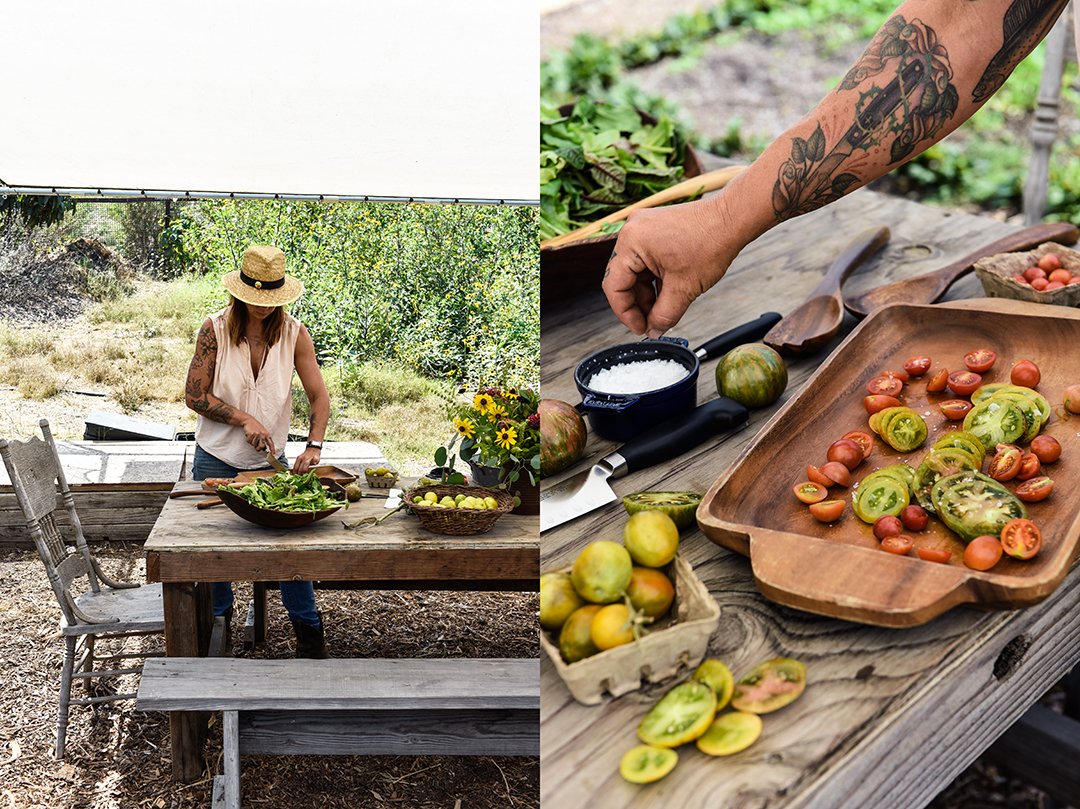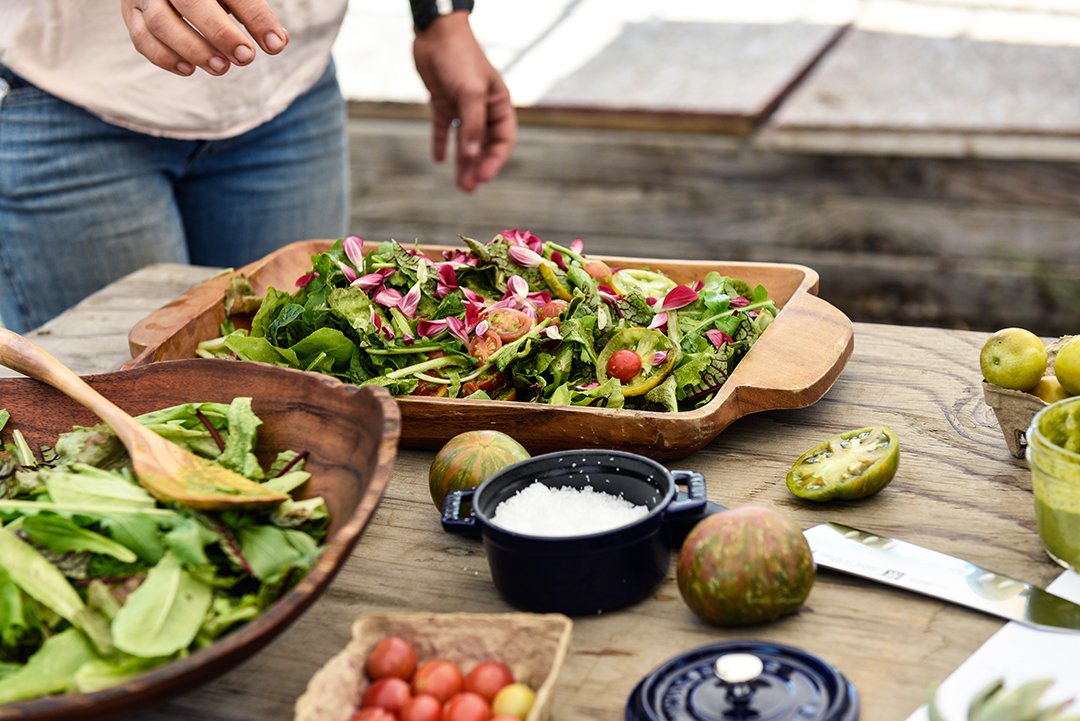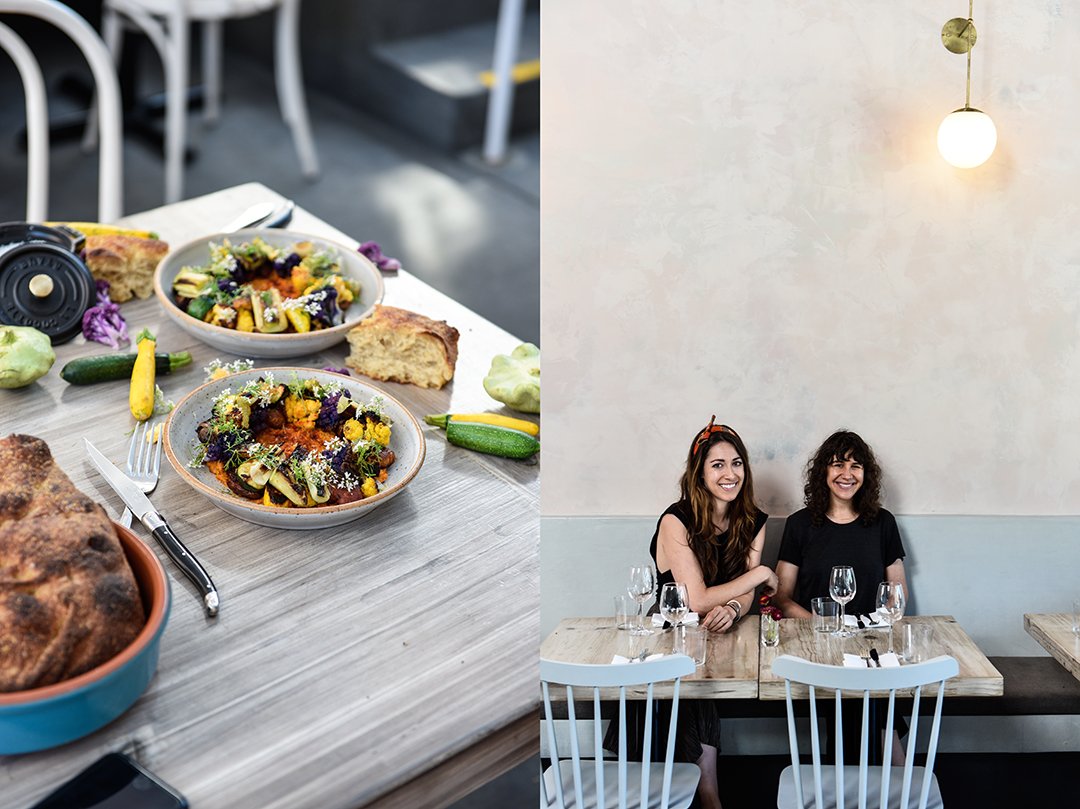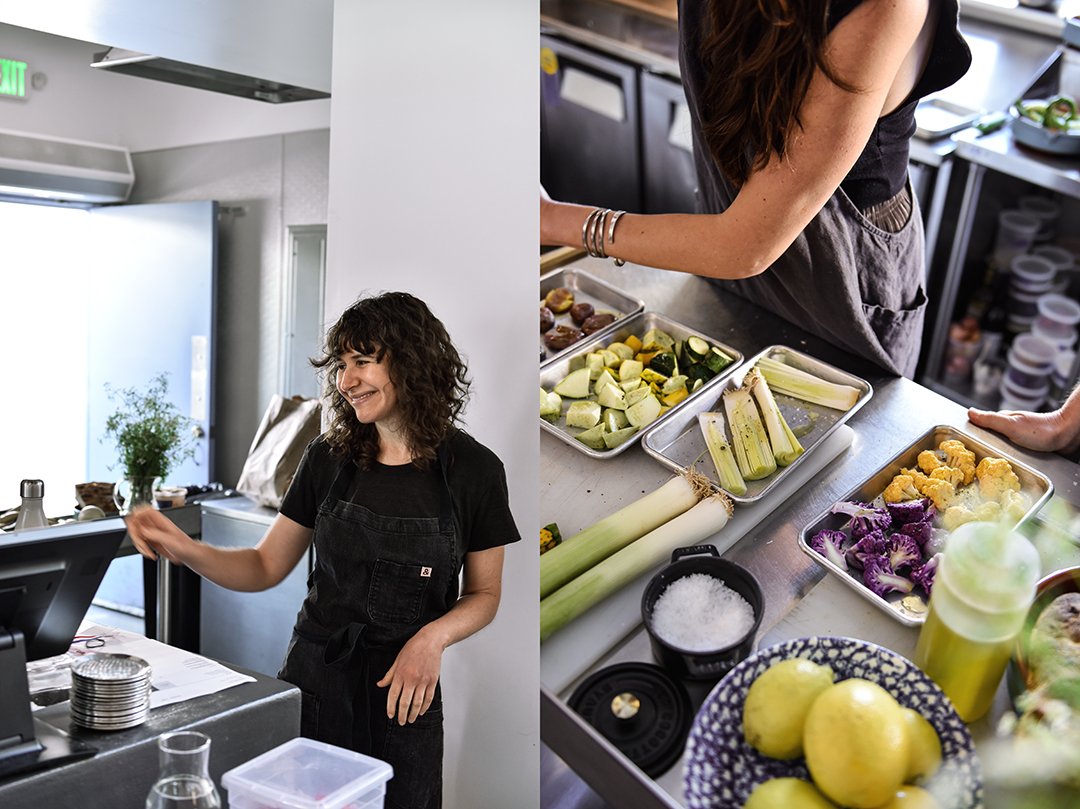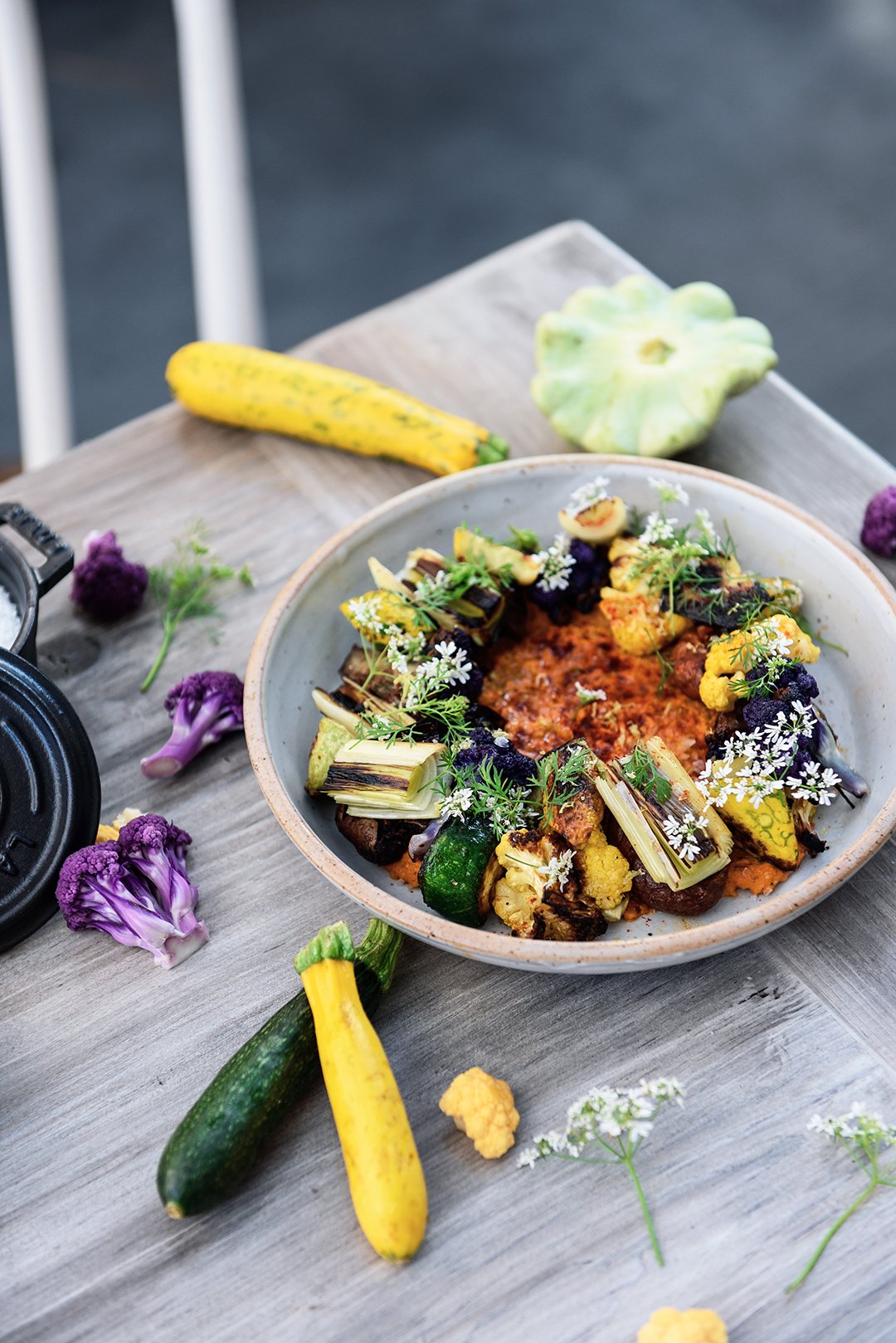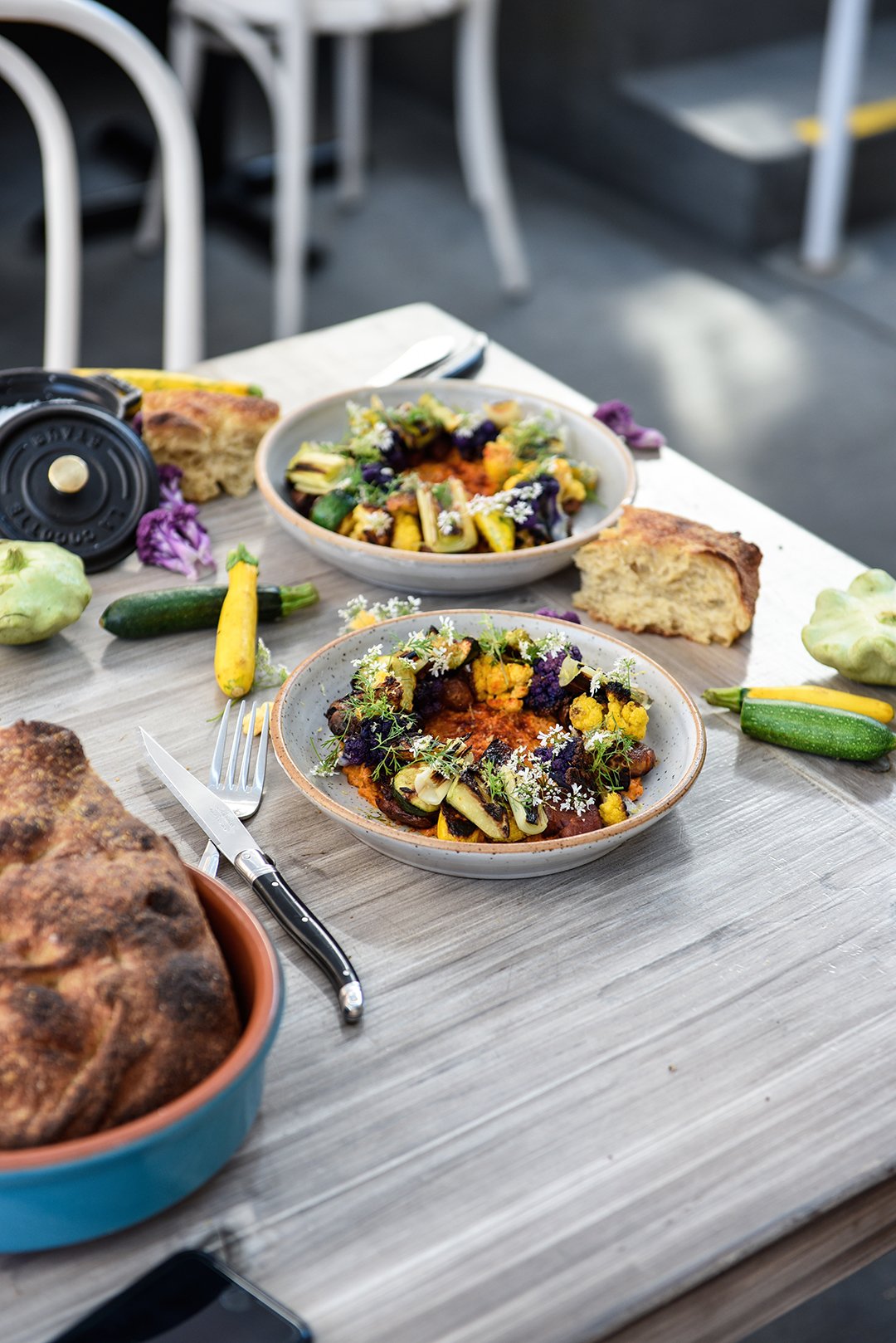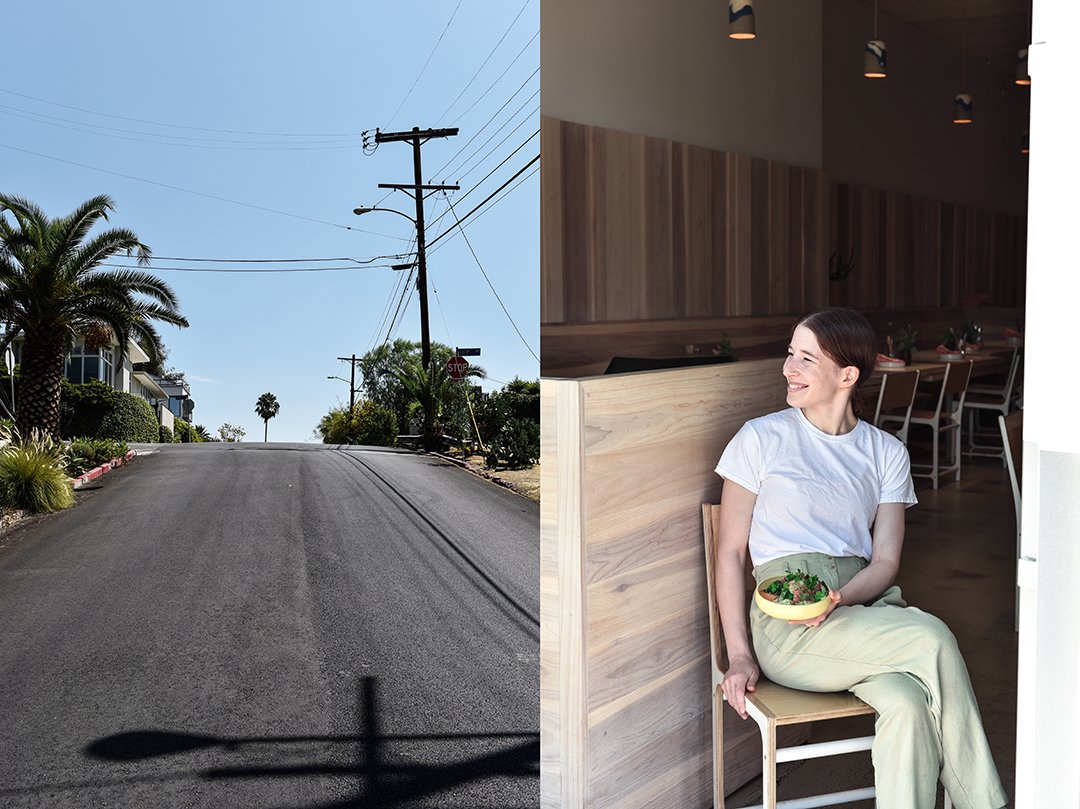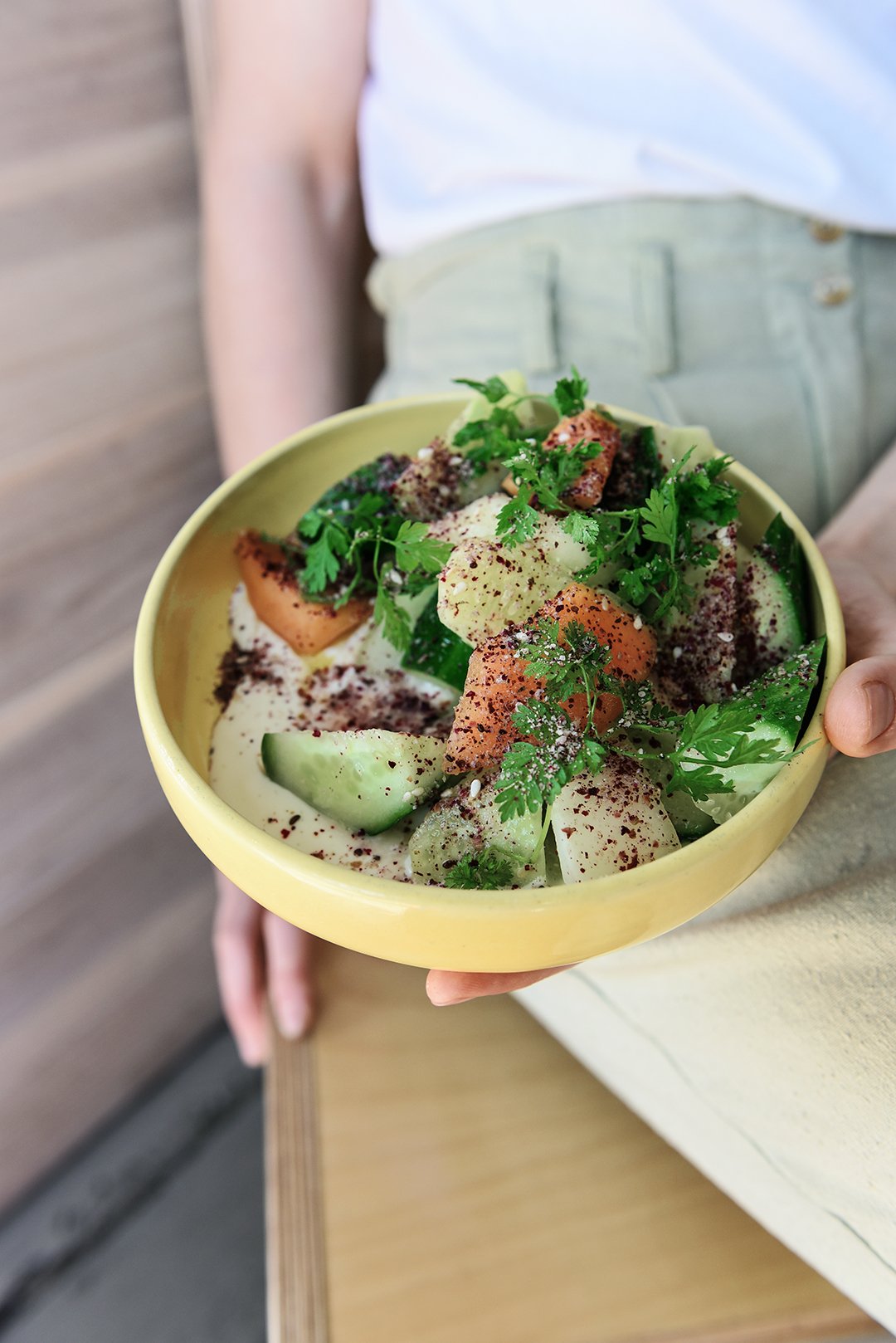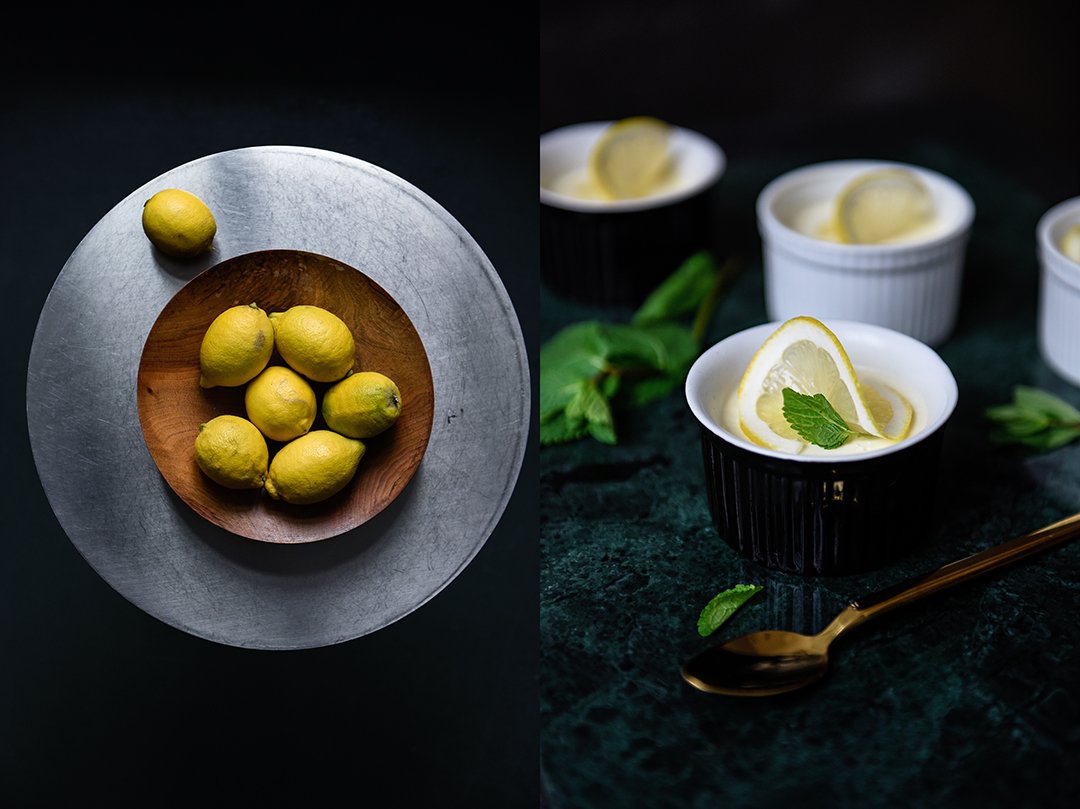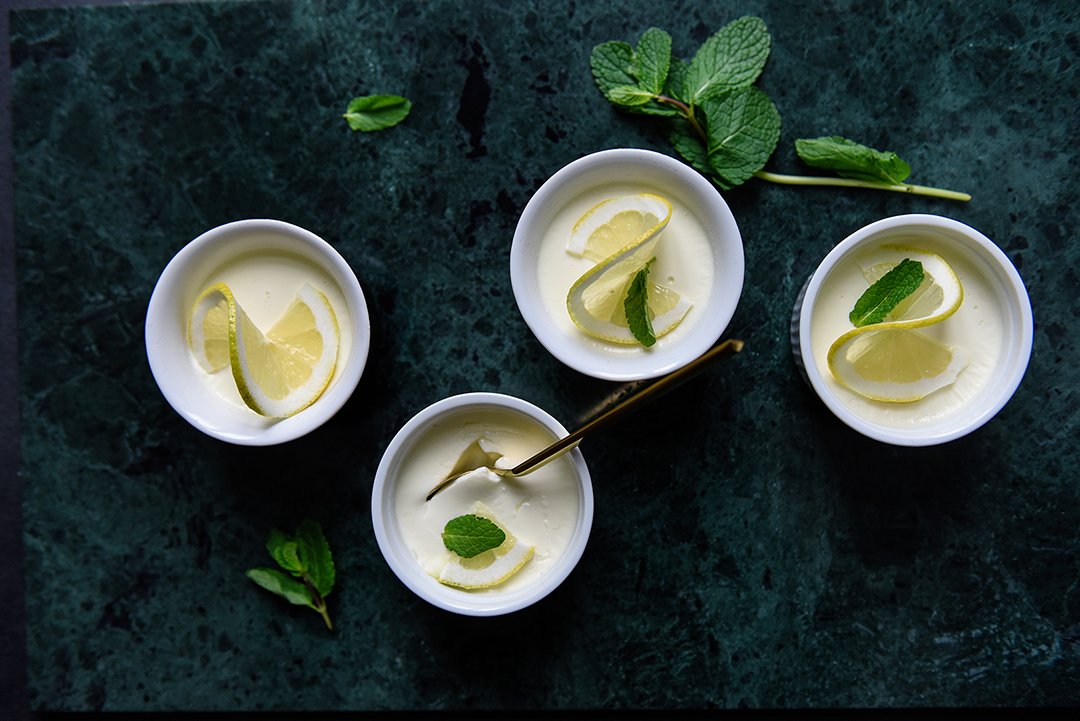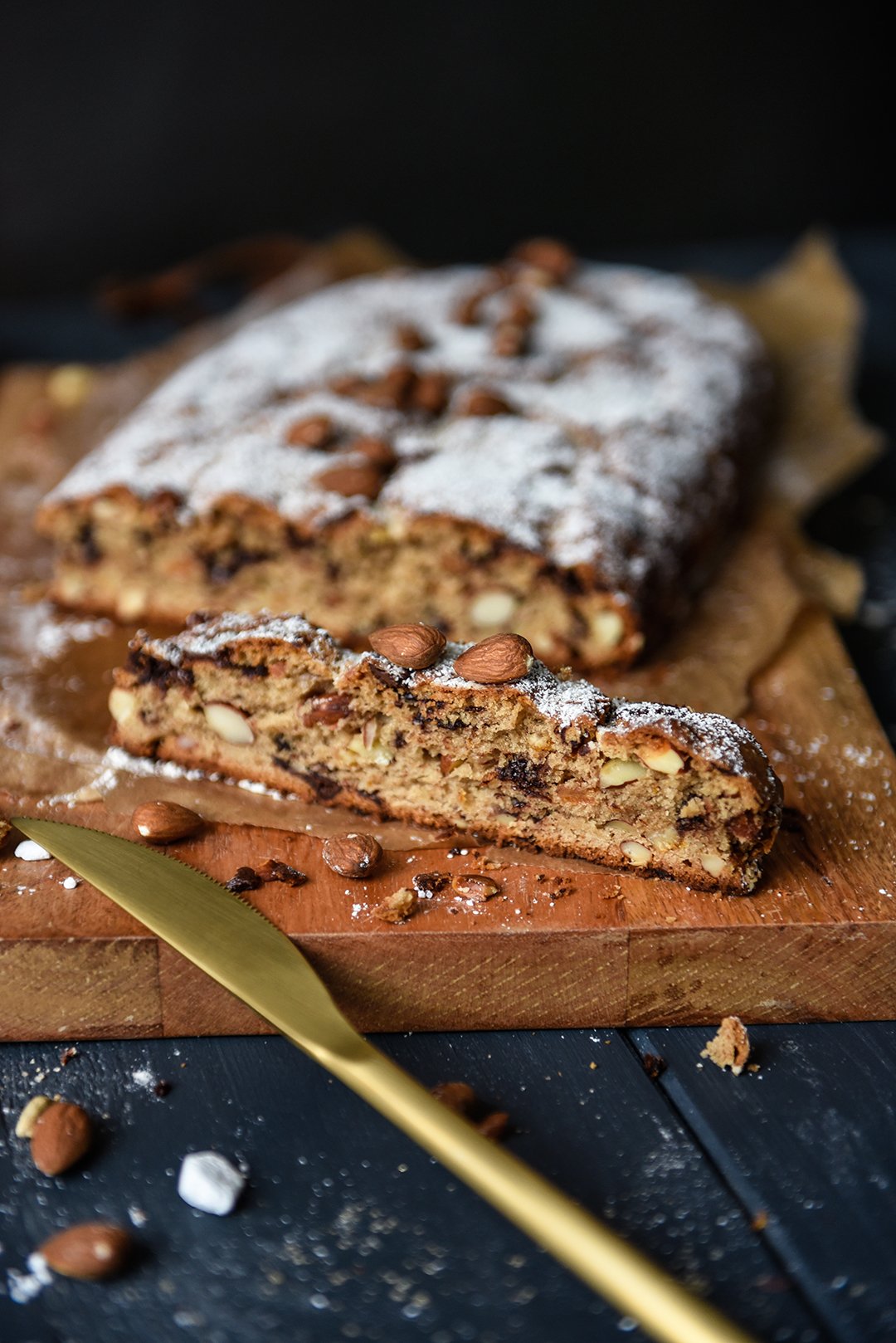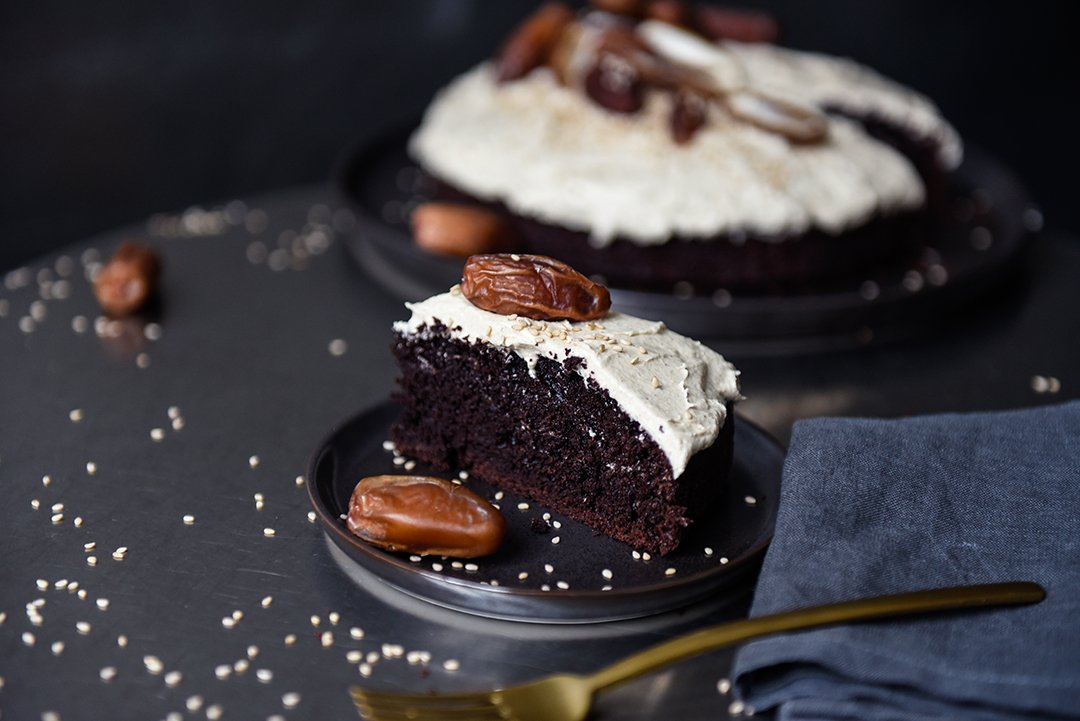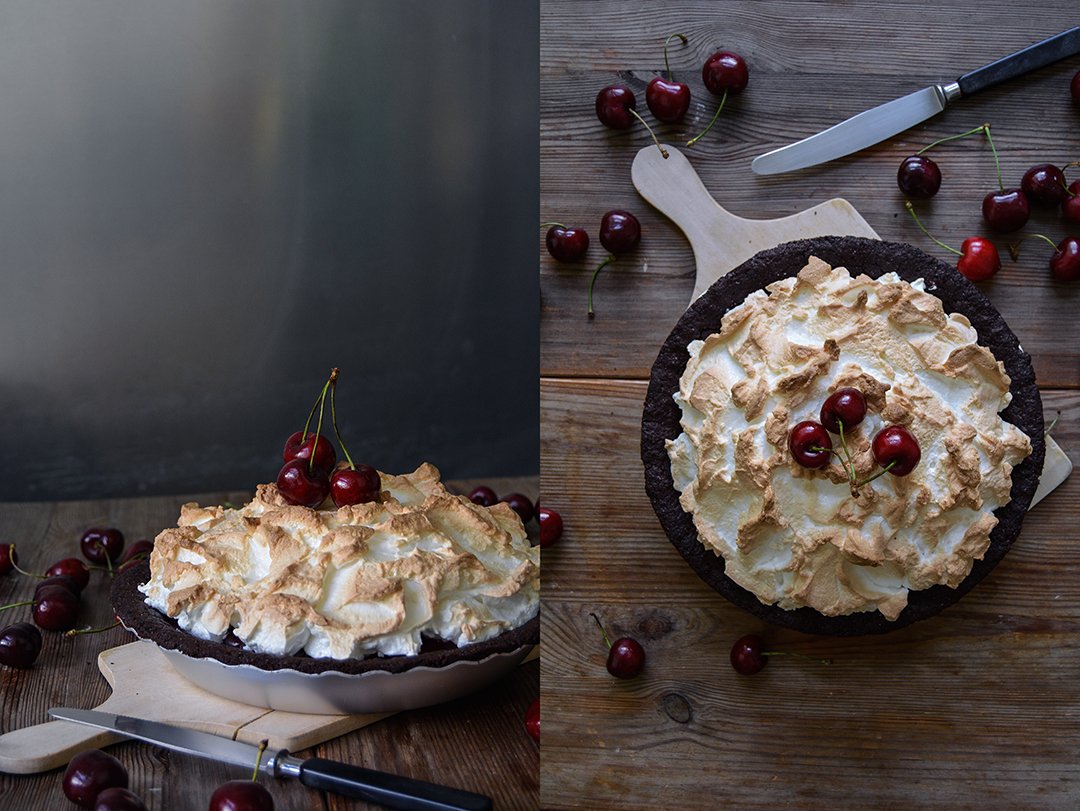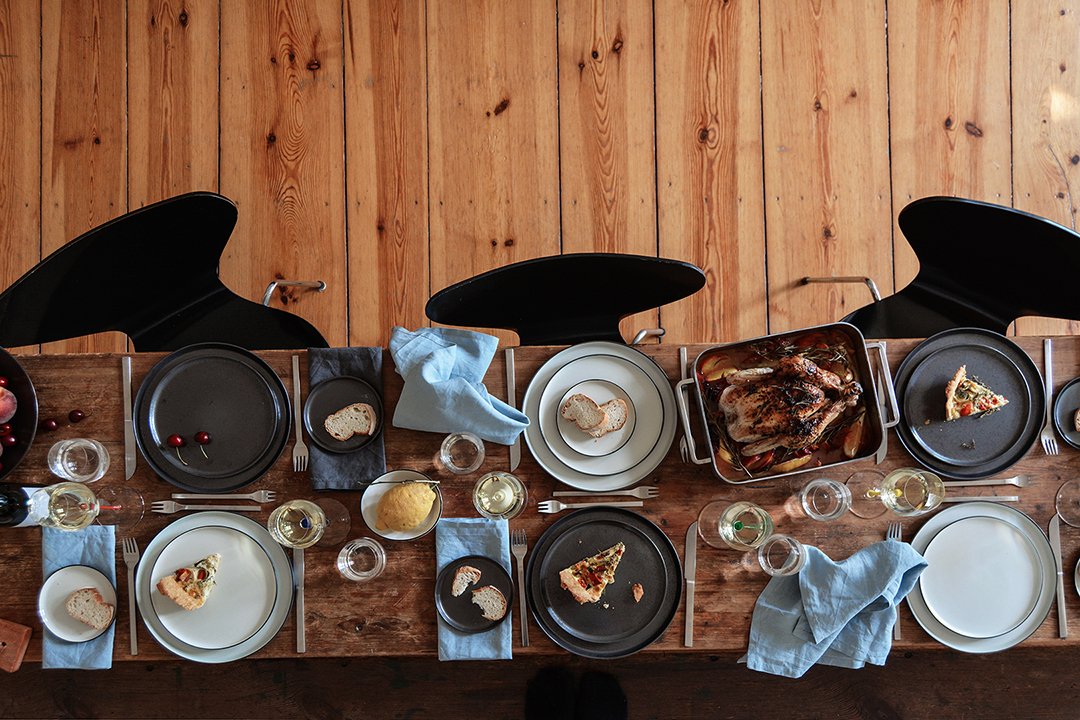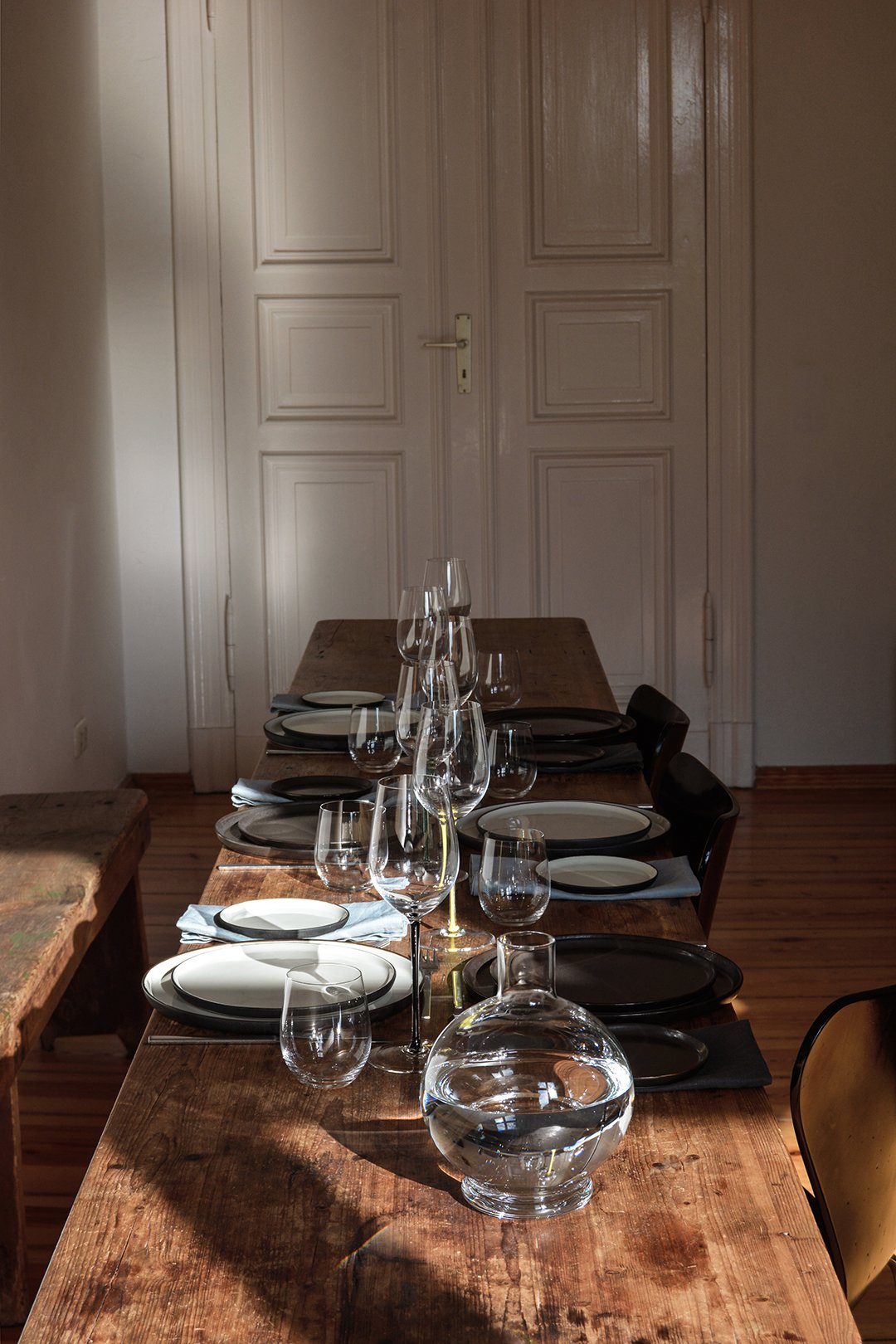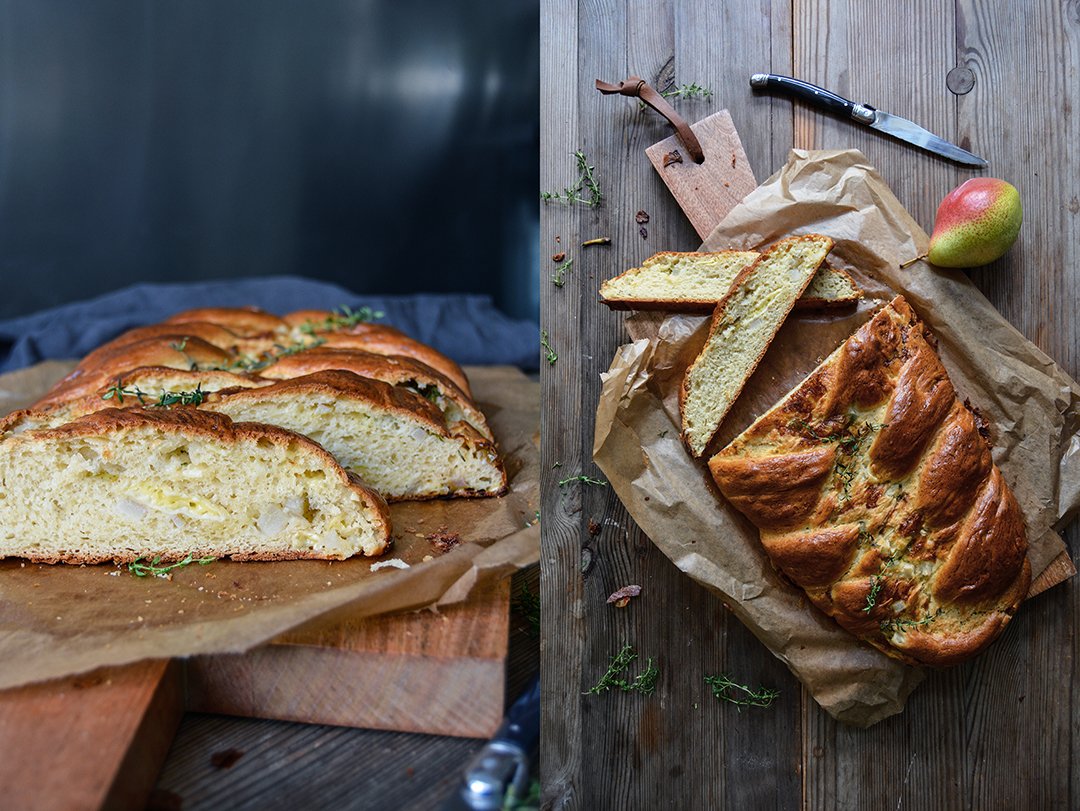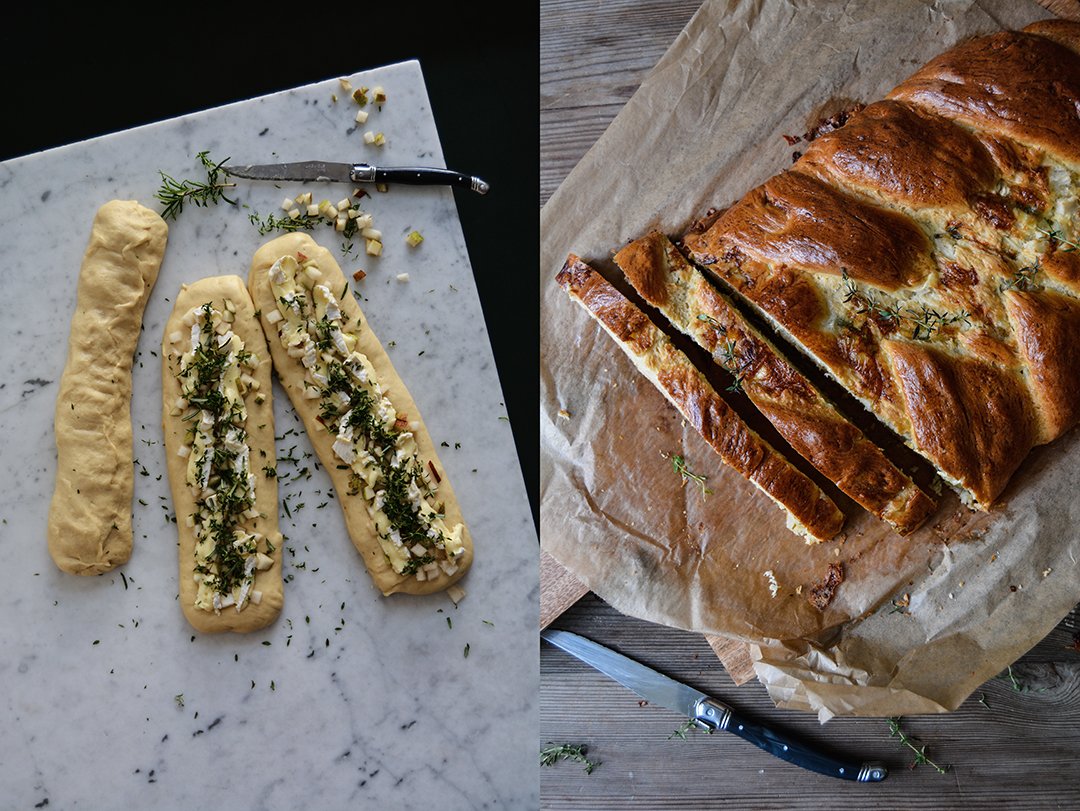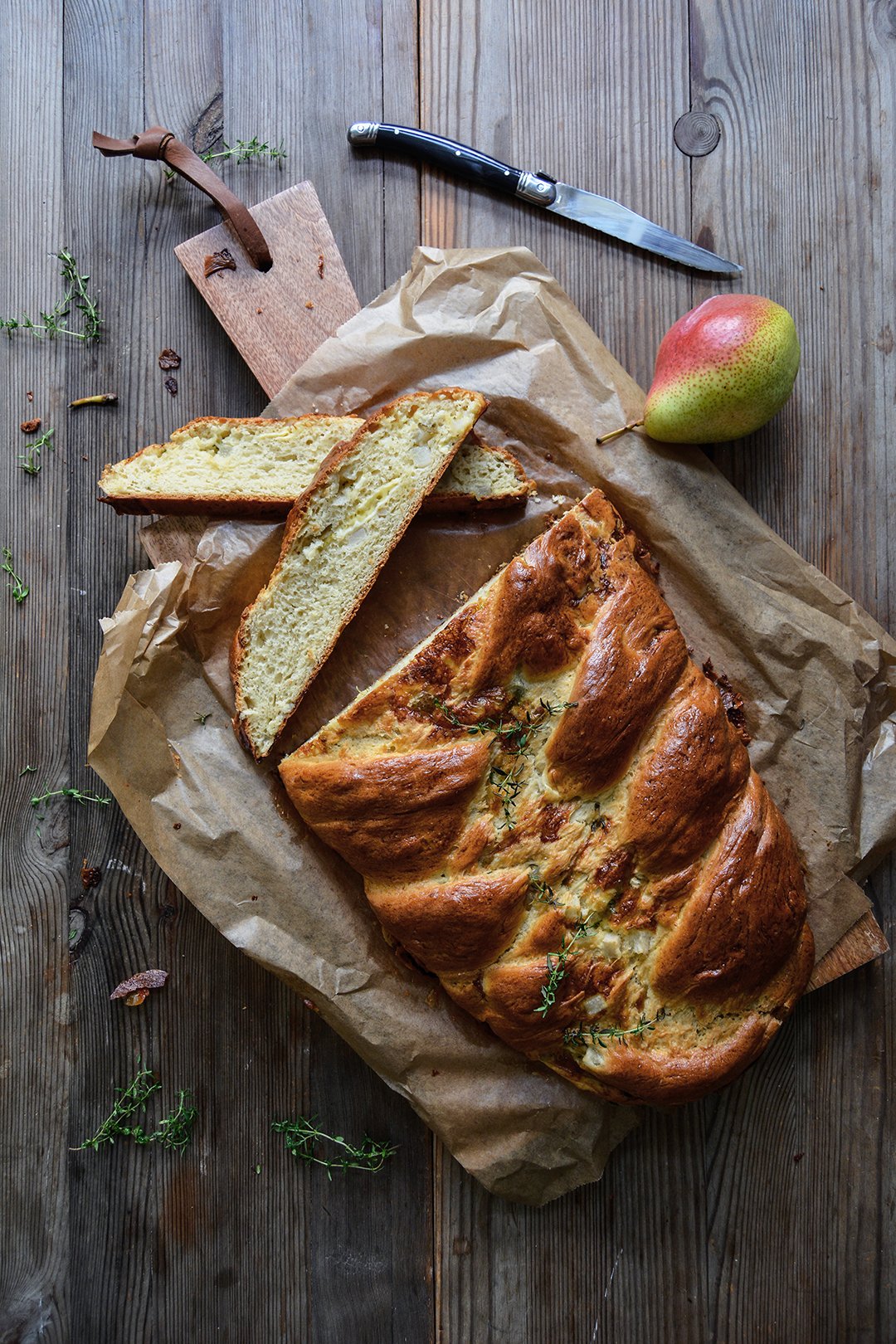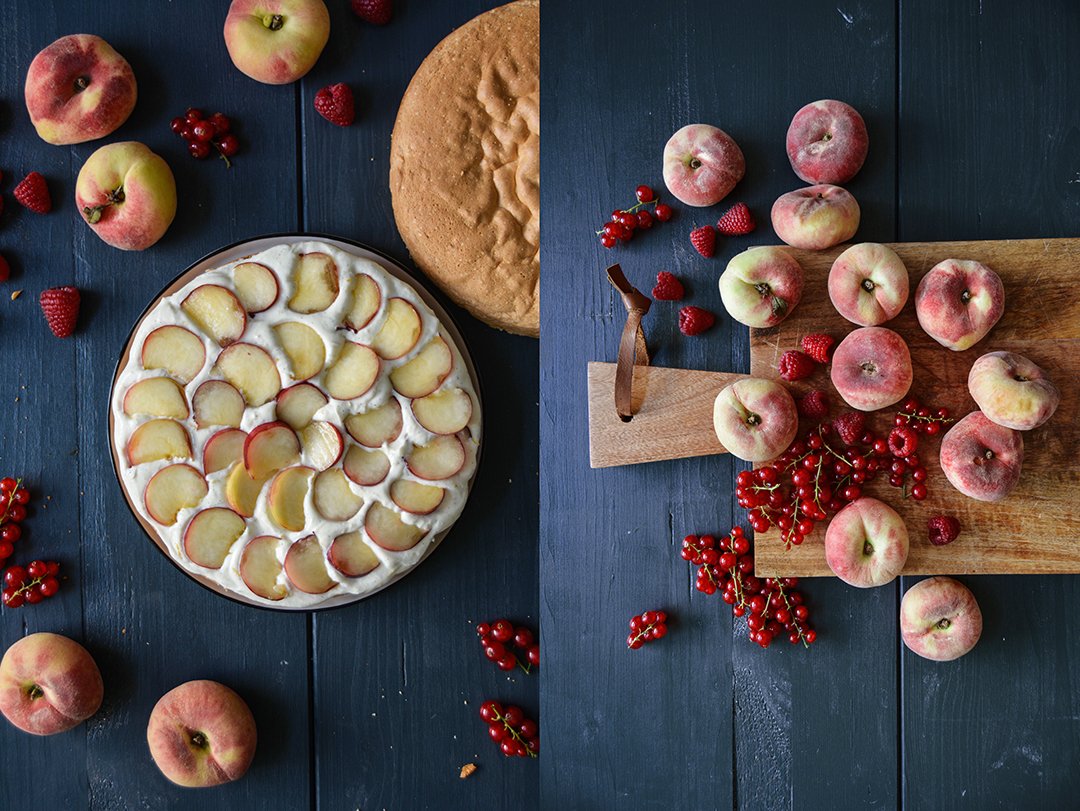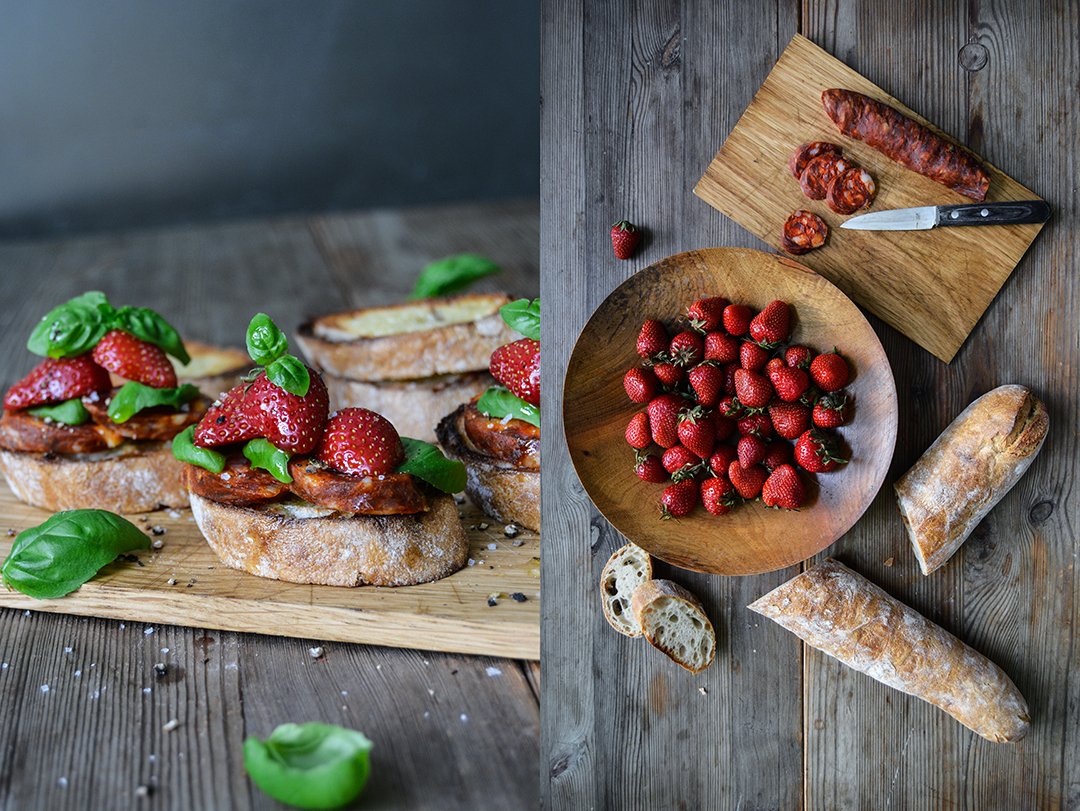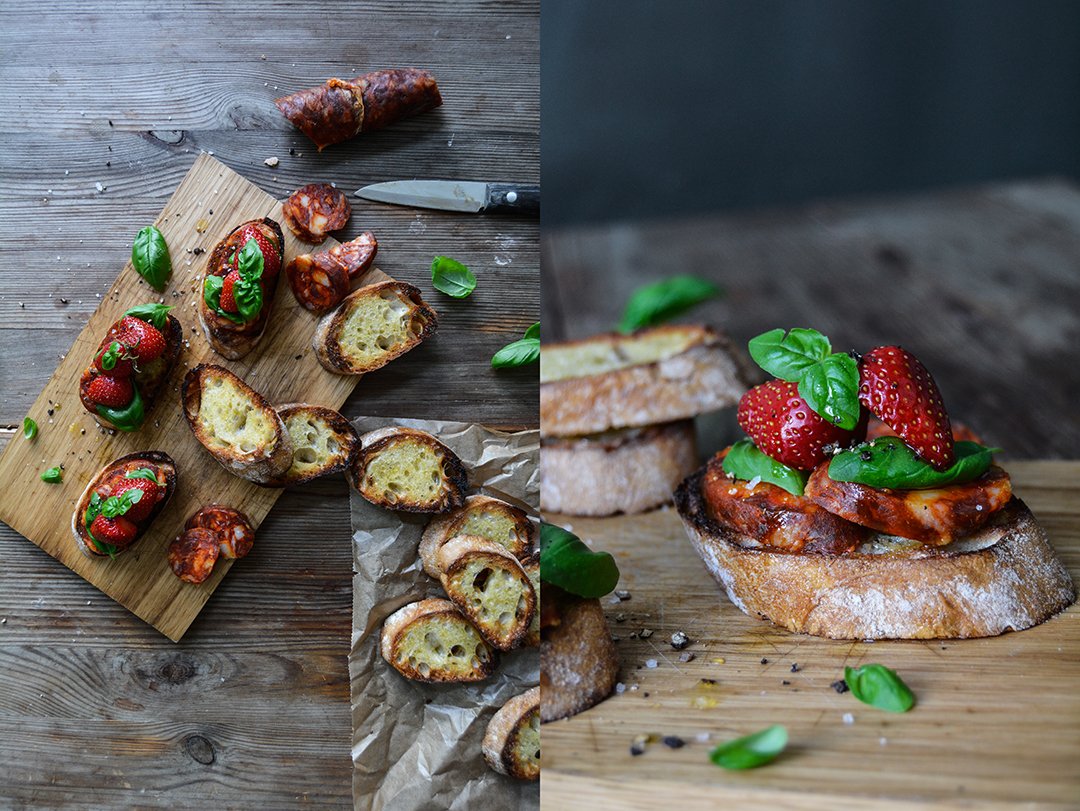Meet In Your Kitchen I Maria Sinskey's Culinary Take on Napa Valley
The air is hot and dry in Napa, not the slightest movement, it stands still, wrapping the hills and vines in a magical silence.
We first stopped at a lake, Lake Hennessey, on our way to meet the Sinskeys at Robert Sinskey Vineyards. The scene was too peaceful and beautiful, as perfect as a postcard, the calm water spread out in front of us. A man sat at the sandy bank staring into the bluest sky reflecting on the water's surface, I walked through the swaying grass and my film team made jokes about unseen alligators. Later, Maria Sinskey told me that there are rattlesnakes in the area – sometimes it's good not to know the danger around you and enjoy the moment.
I had seen the wines of the Robert Sinskey Vineyards on the menu of some of the best restaurants in San Francisco, friends praised the quality of their reds and whites, so there were enough reasons to pick this particular wine maker in Napa on my culinary trip through California. But what struck me goes beyond an excellent bottle of wine: it's the Sinskeys' philosophy of making honest wine, their work ethics oblige them to take care of their team, who also hold shares of the company and have been with the wine making couple for decades. Maria and Robert create an environment of togetherness, they cherish people, nature and its gifts, they live a good life and share it with the ones around them.
Robert Sinskey was a photographer in advertising, he's an artist, a philosopher, he never went to a wine school, but maybe that's the reason why he makes good wine. It was a call from his father 25 years ago that changed his life, Sinskey senior needed help at his wine business, and young Rob fell in love with his new obsession for grapes and what you can do with them. He turned the 200 acres of premium vineyards into an organic, biodynamic ecosystem at a time when this step wasn't as popular as today, he was a pioneer, inspired by Rudolph Steiner's 1928 "Agriculture" manifesto. Believing that, if you harvest grapes of outstanding quality, you don't actually have to do much, you can let nature do its thing and trust. In that respect, the Sinskeys feel closer to the European than the American tradition of wine makers. Rob says "wine should not be a quick study, but rather, sneak up on you, seduce you, and evolve in the glass and in the bottle. The goal is to make pure wines of character that pair well with cuisine." And now, his wonderful wife Maria comes in.
Maria Sinskey is an acclaimed chef and cookbook author from New York, she's the cooking soul of the winery. She worked at Michelin starred restaurants in France but when Rob won her heart, she moved to Napa and set up her beautiful open Vineyard Kitchen right in the heart of the winery's rustic stone building, next to the wine tasting room. It's not a restaurant, you can only book and enjoy her exquisite culinary compositions along with a tasting experience (a visit and reservation is highly recommended). Maria and Rob follow the same credo: nature is good, trust her, treat her well and you'll be gifted. Organic fruits and vegetables come from the garden, sheep grazing the vineyards provide wool and meat, beehives pollinate the orchards and bring the most delicious honey to Maria's kitchen.
You could call it an utopia, you could call the Sinskeys dreamers, but decades of creating fantastic wine and food with and not against nature that people praise all over the world, living and working harmoniously in a community with love and passion, and feeling - as a guest - the spark of happiness and dedication jump over, would prove you wrong.
Maria spoilt us like kids with her elegant, deliciously cozy comfort food. Her duck confit was a revelation and her herb marinated rack of lamb with sun-ripened tomato and herb blossom salad tasted just heavenly, thankfully she shared the recipes with us.
Check for visits: robertsinskey.com
In the next months, I’ll share many new Meet In Your Kitchen features with you that took me to California, Italy, France, and Japan. Thanks to Zwilling for sponsoring these features for our culinary trip around the world!
Sun-ripened Tomato and Herb Blossom Salad
________________
Herb Marinated Rack of Lamb with Buttered Green Beans, Roasted Potatoes, and Lamb Jus
By Maria Sinskey
Sun-ripened Tomato and Herb Blossom Salad
Serves 6
Capture the flavor of ripe, just-picked tomatoes at their peak with this simple salad. The sweet tomatoes are gently scented with herb and arugula flowers that provide small bursts of intense flavor. Blossoms can be gathered as herb and arugula plants bolt. If herb blossoms aren’t available use small herb sprigs and leaves instead.
6 ripe garden tomatoes, about 2 pounds, assorted colors and sizes
Extra virgin olive oil
Aged balsamic vinegar
Flaked sea salt
Freshly ground black pepper
¼ cup (a handful) mixed herb blossoms – dill, arugula, basil, chive
Core and slice the tomatoes into ¼-inch / ½-cm thick slices and fork-size wedges. Arrange the tomatoes on a serving platter. Drizzle with olive oil and balsamic vinegar. Sprinkle with sea salt and grind a few grinds of black pepper over. Scatter the blossoms over the top. Serve with simple crisp flatbread if desired.
________________
Herb Marinated Rack of Lamb with Buttered Green Beans, Roasted Potatoes, and Lamb Jus
Lamb Jus (to serve with the rack of lamb, can be prepared in advance)
Yield: 2 cups (470ml)
1 head garlic, cut in half horizontally
4 tablespoons unsalted butter, divided
2 medium shallots, peeled and sliced thinly
1 cup (240ml) red wine
4 cups (950ml) lamb stock
1 medium plum tomato, fresh or canned
1 3-inch / 8-cm sprig rosemary
Kosher salt
Freshly ground black pepper
Preheat the oven to 375°F (190°C). Wrap garlic in aluminum foil and bake until garlic is aromatic, soft and caramelized, about 45 minutes. Reserve.
Heat a 3-quart / 2.8-l saucepan over medium-high heat, then add 1 tablespoon butter. When the butter starts to brown, add the shallot and cook for about 2 minutes until the shallot is wilted and starting to turn golden.
Add the wine and bring to a boil. Reduce heat and simmer until wine is almost dry, about 10 minutes. Add the lamb stock, roasted garlic head, tomato, and rosemary spring. Bring to a boil and then reduce to a simmer. Simmer until stock is reduced by half. Strain the jus into another pan and season to taste with salt and pepper. Reserve at room temperature for up to 4 hours otherwise refrigerate.
To serve: Return sauce to a simmer. Check seasoning, then whisk in the remaining 3 tablespoons of butter until emulsified. Serve immediately.
Herb Marinated Rack Of Lamb
Serves 8
The herb marinade for the rack really perfumes the meat if it is done a day or two ahead of time. The same marinade can be used for many other cuts as well. It is best to remove as many of the herbs and garlic before roasting as they will burn and create off flavors.
2 lamb racks, 8-9 ribs each
¼ cup (60 ml) extra virgin olive oil, plus 2 tablespoon for roasting the meat
4 garlic cloves, unpeeled and crushed
2 4-inch / 10-cm rosemary sprigs, crushed
6 thyme sprigs, crushed
4 rosemary sprigs for garnish
Sea salt
Freshly ground black pepper
Clean the rib bones well by scraping off meat and sinew with a small sharp knife. Cut the racks in half so that each has four ribs. Mix together the olive oil, crushed garlic, crushed rosemary and thyme sprigs in a large bowl. Add the lamb and coat well. Grind some coarse black pepper over all. Wrap well and marinate the racks overnight.
The next day prepare the roasted potatoes first, then continue roasting the lamb.
Preheat the oven to 400°F (200°C). Remove the lamb from the marinade and scrape off as many herbs as possible.
Heat a large sauté pan over medium high heat and add 2 tablespoons of olive oil. Season the lamb well with salt; no additional pepper should be necessary, and sear fat side down until golden, about 7 minutes. Turn over so that the fat side is up and roast in the preheated oven for 17-20 minutes for medium-medium rare (120°F / 50°C internal temperature). Let the rack rest for 10 minutes before cutting. Prepare the beans while the meat is resting.
To serve, cut each lamb rack half into 2 equal pieces, two bones per chop, and serve on individual plates or a platter with the roasted potatoes, beans, and lamb jus.
Olive Oil and Sea Salt Roasted Potatoes
Serves 8
2 pounds yellow potatoes, Yukon Gold or similar
Sea salt
3 tablespoons extra virgin olive oil
3 tablespoons unsalted butter melted
Preheat the oven to 425°F (220°C).
Peel the potatoes and cut into ½-inch / 1.25-cm pieces. Reserve in a bowl of cold water to keep from browning.
Fill a large pot with water and bring to a boil, season well with salt. Add the potatoes and boil for 7 minutes until the potatoes are tender. Drain the potatoes into a colander. Make sure they are very dry.
Place the well-drained potatoes in a large sauté pan and toss them with the olive and butter and additional salt to taste. Place the pan in the oven and roast for 30 to 40 minutes until the potatoes are golden and crispy on the edges. Keep them warm.
Buttered Green Beans
½ pound freshly picked green beans or haricot vert
Salt
3 tablespoons unsalted butter
Trim the stem off of the beans but leave the slender pointed tips. Reserve.
Ready a medium bowl of ice water. Bring a large pot of water to a boil. Add salt until the water tastes of the sea. Add the beans and cook until tender about 3-4 minutes. The thinner and fresher the beans the faster they will cook. Remove the beans from the pot with a pair of tongs or skimmer and plunge into the bowl of ice water to stop the cooking. When beans are cool, remove from the ice bath and let rest in a strainer or colander to drain.
To serve: melt the butter in a large sauté pan and add ¼ cup (60ml) water. Bring to a boil to emulsify, season with salt to taste. Add the beans and toss until heated through. Remove with tongs to a serving plate. Serve immediately.
Watch my interview with Maria in Napa in September 2017:
Thank you, Maria!
Meet In Your Kitchen | Jessica Koslow's Sqirl in LA & the Magic of Sorrel Pesto Rice
It's captivating to watch a craftswoman concentrating on her material, a carpenter choosing the right piece of wood, a tailor feeling the fabrics, or a chef taking about a new recipe and picking the right ingredients. Jessica Koslow is a craftswoman, but she's equally an artist gifted with a huge sense for freedom and creativity and this shines through every single one of her creations. She's also a scientist who critically re-thinks all the single components of a dish until the final result is complete, until the textures and flavors feel aligned, until it looks deliciously tempting. This woman is so much, which makes her one of the leading figures of a new powerful movement of female chefs in California, but also in the rest of the world.
Sqirl is located just around the corner from Vermont Avenue that leads straight to Griffith Park, the restaurant is almost unspectacular, pleasantly unpretentious and casual, but the dishes that come out of the kitchen can easily compete with Michelin starred restaurants. The open kitchen works smoothly, peacefully, every chef seems to deeply enjoy the part they have in the Sqirl universe, it's a bit like friends cooking, just more precise. Like the Sorrel Pesto Rice, inspired by Pierre Troisgros, the father of the nouvelle cuisine movement, that blew my mind: Kokuho rose brown rice, sorrel pesto, preserved meyer lemon, lacto-fermented hot sauce, watermelon radish, French sheep feta, and a perfectly poached egg spreading its shiny liquid yolk all over this vibrant composition. And the Sqirl Chicken Salad with Marin Sun chicken, bok choy, dehydrated citrus and root vegetables, grated carrots, and black garlic vinaigrette balances crunch and tenderness, sweetness and bitterness, it's a dish that excites and satisfies.
Jessica comes across as very relaxed, she laughs a lot, but when you ask her a question she pauses and takes her time to think, to answer with the same precision you can find in her dishes, in the same way that she designed her restaurant, and how she put her first cookbook together, Everything I Want to Eat: Sqirl and the New California Cooking. There is a vision that only she can see that seems to guide her in the right direction. She used to be a competitive figure skater which explains her discipline and dedication, and when she stopped at 19, she channeled her obsession into something new: food.
From then on it was all about cooking, eating, and tasting. She was fascinated by the moment when you put the first bite into your mouth and you're overwhelmed. That's the experience she wants to create at her restaurant and she knows that she only has this first second to reach and convince her guests' taste buds. She and her team are gifted with outstanding produce, which she honors in her creations and that she receives from farmers who are friends and part of her community. This is the foundation of her work: "Raw produce defines a season, it's the passing of times and in California, thankfully, it's such a delicious marker of time. Our produce is an exciting time stamp and a building block from there." The Sqirl world is about dishes that feel familiar and unfamiliar at the same time, they create comfort and inquisitiveness, it's about different layers and textures, using the raw natural produce, but also playing with it, fermenting, pickling, or dehydrating it. As exciting as it is to eat this woman's food, it's a pure pleasure listing to her words.
Sqirl is a breakfast and lunch spot only, but in 2018 Jessica will open a dinner place for all her begging, hungry fans, called Tel - keep your eyes and ears open!
In the next months, I’ll share many new Meet In Your Kitchen features with you that took me to California, Italy, France, and Japan. Thanks to Zwilling for sponsoring these features for our culinary trip around the world!
Jessica Koslow's Sorrel Pesto Rice
Serves 6
3 cups (600 g) medium-grain brown rice, preferably Kokuho Rose
Fine sea salt
½ cup plus 2 teaspoons (130 ml) extra-virgin olive oil
1 cup (25 g) lightly packed kale leaves (stems removed)
2 cups (50 g) lightly packed chopped sorrel leaves
3 tablespoons fresh lemon juice
2 tablespoons chopped fresh dill, plus more for serving
1 Preserved Meyer Lemon, flesh removed, peel finely chopped
2-4 small watermelon radishes, very thinly sliced
¼ cup (60 ml) Fermented Jalapeño Hot Sauce
¾ cup (85 g) crumbled sheep’s-milk feta
6 poached eggs
Fleur de sel
Freshly ground black pepper
Boil the rice in plenty of salted water until it’s tender, 30 to 45 minutes. Drain and let cool.
Meanwhile, make the sorrel pesto: In a blender or food processor, combine ½ cup (120 ml) of the oil, kale, sorrel, and 1 tablespoon of the lemon juice. Blend until smooth, stopping and scraping down the sides as needed. Season with salt to taste.
In a large bowl, toss the rice with the dill, preserved lemon peel, 1 tablespoon of the lemon juice, and the pesto. Taste and add a bit more salt, if needed.
In a small bowl, toss the radish with the remaining 1 tablespoon lemon juice, the remaining 2 teaspoons oil, and a pinch of salt. Set aside to marinate for a few minutes, until the radish is pliable and tender.
To serve, divide the rice among six bowls. Spoon a line of hot sauce across the rice. Arrange a little clump of feta on one side and a rosette of radish slices on the other side. Set a poached egg in the middle of each bowl and season it with fleur de sel and black pepper. Garnish with a tiny sprig or two of dill.
Watch my interview with Jessica in LA in September 2017:
Thank you, Jessica!
Jessica Koslow
Meet In Your Kitchen | Urban Farming and a Garden Salad at LA's Farm Lot 59
A 1-hour drive, leaving the skyline and the buzz of Downtown LA behind, and you're in Long Beach, still LA county, yet a totally different scene. As we left California Avenue in the south and drove our bulky van down a dusty road for a new Meet In Your Kitchen feature together with Zwilling, the inspiring urban farmer Sasha Kanno welcomed us with a big smile in front of the gate of her green oasis, Farm Lot 59.
Sasha is a woman with a strong vision and principles, she believes in honest food, available not only for herself, but also for the community that she lives in. She took over the land surrounded by urban industrial buildings in 2010 and turned it into a non-profit organic farm, practicing biodynamics and following the Waldorf School philosophy. The farmer who's fascinated by rare and heirloom varieties and who gets many of her seeds from a 100-year old seed company in Honolulu, is famous and loved by locals and chefs for her outstanding lettuce and herb mixtures. All year round, she puts an exciting seasonal bouquet together, of arugula, lemony blood sorrel, giant red-leaf mustard lettuce, basil (with a rough surface), huacatay (black mint), cilantro, fennel, tarragon, thyme, chocolate mint, and many more. Her edible flowers, such as pensi, dahlia, dianthus, calendula, lavender chamomile flowers, are a feast for the eye and an explosion of flavors for the palate.
However, as much as she loves to share the produce from her garden with other passionate lovers of natural, healthy fruits and vegetables, Sasha felt that there was more for her to do. She started an educational program of cooking and gardening classes, she wanted to bring the basics back to the table of our children: her tomatoes, beans, eggplants, pumpkins, squash (I learnt that you can even eat its leaves cooked like a vegetable), peppers, snake melon, and artichokes. She wanted them to smell again and listen to the sounds of the woods and fields, and taste pure unprocessed food. She saw city kids who were totally overwhelmed by this experience, being confronted by nature, even stressed some of them. Some of the most common fruits and vegetables had never been in the hands of these children before. It's an essential experience, if not a right to have access to food in its original form. Sasha takes responsibility to teach them about our fragile ecosystem, so that future generations adjust the way that we deal with ourselves, our food, and our environment.
The doors of Farm Lot 59 are open almost every day and it's worth visiting this green paradise framed by apple, stone fruit, and guava trees. You can buy the handpicked produce and humanely sourced meats, dairy products, and eggs from friends and other farmers at the farm's market stand at the street, the Farmstand 59. And then you go home and prepare the beautiful salad that Sasha made for us in her outdoor farm kitchen: a colorful tomato salad with the farmer's delicious basil vinaigrette featuring the pure taste and beauty of this sweet fruit and fragrant herb!
In the next months, I’ll share many new Meet In Your Kitchen features with you that took me to California, Italy, France, and Japan. Thanks to Zwilling for sponsoring these features for our culinary trip around the world!
Sasha Kanno's Tomato Salad with Basil Vinaigrette
Serves 4
For the dressing
1 cup (240ml) olive oil
2 tablespoons red wine vinegar
1 red onion, roughly chopped
2 cups fresh Tuscan basil
1 clove garlic
½ teaspoon haberno salt (haberno peppers mixed with sea salt)
For the salad
8-12 green, red and yellow ripe tomatoes (of various sizes), sliced
2 large handfuls mixed young lettuce greens
1 small handful edible flower petals
For the dressing, purée the ingredients in a blender until smooth and season to taste with salt. Add more oil if the dressing is too thick.
Spread the lettuce greens and tomatoes in a large bowl, sprinkle with the dressing and flower petals and serve immediately.
Watch my interview with Alana in LA in September 2017:
Thank you, Sasha!
Meet In Your Kitchen | Heather and Emily celebrate LA's vegetables at Botanica
One of the kitchens that I visited on my trip to LA - the first stop of my new adventure together with Zwilling - was at Botanica, a stunningly beautiful restaurant founded by the wonderful Heather Sperling and Emily Fiffer. Both women had been working in the food industry as editors on the East coast for more than a decade, but they were hungry for more. They chose LA to bring a project to life, giving it all their love, passion, and honest determination. An old run-down liquor store in Silverlake looked less than promising when they first saw it, but Heather and Emily knew from the start that this would be the right place to give their vision a home. They gutted it and after a year of sweat and work you can't even imagine how this gorgeous bright and airy space looked before the renovations. A tall wall touched up in a soft Tuscan pink holds the old wooden beams above the restaurant's rustic wooden tables and the little market where you can buy the products and produce used in Botanica's kitchen.
The two ladies also started an online magazine, a collection of the recipes used at their restaurant to complete their customers hungry needs: you can eat a dish at Botanica, fall in love with it so much that you want to cook it at home, buy the ingredients right away, grab the recipe from the magazine, and go straight to your own kitchen and cook it again.
Sitting at this restaurant feels a bit like being in Heather and Emily's home and this was an important aspect for them when they first started thinking about their restaurant baby. The design, the menu they put together, the way they work together with their employees, this all shows a philosophy of working and living together in a community. They have strong connections with the other restaurants in their neighborhood, many of which are also run by women, and together they put the spotlight back onto LA's culinary scene (like "Kismet" that I wrote about last week and Jessica Koslow's "Sqirl", which will be featured here on the blog in 2 weeks). They not only share the same work ethics, but also their farmers and suppliers.
And they all have one more thing in common, all these restaurants celebrate vegetables. Heather and Emily manage to turn a potato, cauliflower, squash, or carrot into a vibrant feast. They shift the traditional focus from meat and seafood centric dishes to roots, cabbages, and legumes. Botanica is not a vegetarian restaurant, but ribs, steaks, or fillets aren't the star of the meal anymore, they can be a part of a greater composition, add flavor, be a luxurious treat of outstanding quality, but they aren't essential anymore. And the two women's recipes are so fantastic that you won't even miss it, you just indulge in a dish like their seared vegetables with romesco (recipe below), which is so rich, balanced, and exciting that you don't ever think of anything but tasty vegetables. And apart from this more than satisfying pleasure for the taste buds, you can be sure that you just enjoyed food that is good for your body, locally sourced in a strong community that works with and not against nature and our environment.
In the next months, I’ll share many new Meet In Your Kitchen features with you that took me to California, Italy, France, and Japan. Thanks to Zwilling for sponsoring these features for our culinary trip around the world!
Heather Sperling and Emily Fiffer's Seared Vegetables with Romesco
Serves 4
For the romesco
4 red bell peppers
1 jalapeño, seeds removed
2 medium cloves garlic
¼ cup (60ml) olive oil
1 tablespoon sherry vinegar
1 small lemon, zest and juice
2 teaspoons Spanish smoked paprika
1 cup (140g) toasted almonds
1 large handful fresh cilantro leaves (about ¼ cup chopped)
Sea salt
For the vegetables
20 tiny potatoes (preferably purple), boiled in salted water until just tender, drained and cooled
Olive oil
Sea salt
Black pepper
Spanish smoked paprika
Broccolini, summer squash, romanesco, Brussels sprouts or cauliflower (or a mix)
3 leeks, white and light green part only, cut in half lengthwise
For the topping
About ½ lemon, zest and juice
1 small handful fresh cilantro flowers (or cilantro leaves)
Preheat the oven to 450°F (230°C).
To make the romesco: Roast the bell peppers until blistered and fully soft. Transfer to a large bowl and let them cool for a few minutes. Remove and discard the seeds and stems, collect the thick juices that run off the peppers. Peel the skin and set aside.
In a food processor, combine the roasted peppers and their skin, the jalapeño, garlic, olive oil, vinegar, lemon zest and juice, smoked paprika, almonds, cilantro, and a splash of the liquid from the peppers. Blend until fully incorporated, but not fully uniform; some texture is ideal here. Add more sherry vinegar, salt, olive oil, and cilantro to taste.
For the vegetables: Lightly crush each potato with the side of a knife. Heat a splash of olive oil in a pan over medium heat and sauté the potatoes on one side until just starting to crisp, then flip and crisp up the other side. Remove from oil and season well with salt, pepper, and a sprinkle of smoked paprika.
While the potatoes are crisping, prepare the remaining vegetables: Cut the vegetables into bite size pieces (except the leeks) and toss with olive oil, salt and pepper, then grill or sear until al dente, with nice char in spots. In a large pan, cook the leeks, cut-side down, until they get a touch of caramelized char, then flip and cook for a few minutes on the other side, until soft through. Cut in two-inch lengths, season, and set aside.
Mound the romesco in the center of a large plate and arrange the potatoes, leeks and vegetables in a ring around the purée. Garnish with a good drizzle of olive oil, a squeeze of lemon juice, lemon zest, a sprinkle of salt, and the cilantro flowers and serve immediately.
Watch my interview with Heather and Emily in LA in September 2017:
"I think that for many women in the industry, they are very aware that this is a moment in time when they can be actively involved in changing the culture of the restaurant world."
Thank you, Heather and Emily!
Meet In Your Kitchen | Kismet LA's Persian Cucumbers, Melon & Rosewater Labneh
White brushed walls, pale wood, and strong geometric lines turn Kismet into a minimalist spot of casual elegance right on LA's sunny Hollywood Boulevard. Sitting on the wooden bench at the wide window, the fleshy leaves of a tall banyan tree playing with the light, I felt immediately captured by the restaurant's laid-back vibe and exciting Middle Eastern and Mediterranean-style menu.
Sarah Hymanson and her partner Sara Kramer created a beautiful place to enjoy breakfast, lunch, or dinner with a group of friends - following their philosophy that food tastes best when you share it. Kismet is a neighborhood hub where you can fill your table with plates full of colorful vegetable focused delicacies and indulge in the pleasures of wonderful treats such as Little Gem Lettuce with Plums, Sprouted Lentils and Tarragon, Freekeh Polenta with Lamb, Green Chili, Greens and Poached Egg, or the wonderful Persian Cucumbers with Melon, Rosewater Labneh and Parsley Seed Za'atar – this recipe is a feast for the taste buds thankfully shared with us by the two chefs. You just dig in and feel happy, inspired by new flavor combinations focusing on taste and freshness. Or celebrate some precious time just for yourself and a book, have a coffee, and nibble on a Scone with Lemon Cream or Brioche Toast with Date Butter.
"LA is an exciting place to be right now, there's a lot of young creative energy", Sarah says. She doesn't hide that she loves the East coast, she's from Chicago and worked in New York for years, moving west wasn't an obvious step for her. In 2015, she met NY native Sara Kramer at Glasserie in New York, Kramer was the opening chef at the acclaimed restaurant and won Eater's NYC Chef of the Year award for her celebrated way of cooking. Yet the two strong willed chefs and highly creative minds who developed the vision of opening their own place, had to find out that it wasn't in the East but West, in California, where their first "baby" would open its doors. An organic falafel shop at the lively Grand Central Market in Downtown LA called Madcapra was their testing ground. It became a huge success and so Kismet came next.
Rooted in California through the produce that the Kismet chefs get from their beloved farmers and friends who are such an important part of their community of chefs – "their produce is what makes our food" - yet their style of cooking is very much based on their experiences in the kitchen and their upbringing. Thanks to the similar climate, they can use a lot of fruits and vegetables that are prominent in Middle Eastern cooking, such as pomegranate, dates, olives, and fresh herbs. This is the kind of food that both of them loved all their life, what they grew up with – Sara's mother is Israeli – it's the food that fascinates both of them and constantly feeds their inspiration.
LA has always offered a great platform and an excitable open-minded audience to female chefs, like Nancy Silverton, Suzanne Goin, Marie Sue Milliken, and Susan Feniger to name just a few. There's a history of inspiring women in this city and also in California in general who try alternative ways of producing food, cooking, but also working together. Over the past few years, there have been changes in restaurants all over the US that touch the roots of this industry. Work ethics change, the tone in the kitchen that was very male for decades, changes. "The women today try to challenge these norms by treating people as people. It's not an easy process, but it's a responsibility to the industry and the people working in this industry." Sarah and her partner introduced a 20% service charge on top to improve payments and also even out the gap between front and back of house at their restaurant. It's not easy, but it's an important part of the place that they want to create, where it's about good food, but also about a healthy community, in and outside Kismet.
In the next months, I’ll share many new Meet In Your Kitchen features with you that took me to California, Italy, France, and Japan. Thanks to Zwilling for sponsoring these features for our culinary trip around the world!
Persian Cucumbers with Melon, Rosewater Labneh and Parsley Seed Za'atar
By Kimset / Sarah Hymanson and Sara Kramer
Serves 6
For the Za'atar
2 tablespoons untoasted sesame seed, ground
1 tablespoon whole toasted sesame seeds
¾ cup (about 12g) dried rose petals, broken up
1 ½ teaspoons sumac
1 teaspoon parsley seeds, ground
¼ teaspoon salt
For the rosewater labneh
2 cups (470g) labneh
1 teaspoon salt
Zest of 2 lemons
2 cloves garlic, grated on a microplane
2 teaspoons honey
¼-1 tablespoon rose water, to taste
Black pepper, finely ground, to taste
For the salad
9-12 Persian cucumbers, rinsed, shaved lengthwise on a mandoline
1 cup (about 160g) melon, cut into oblique pieces
Juice of 2 lemons
Olive oil
Salt, to taste
Fresh chervil, leaves only
For the Za'atar, in a small bowl, combine the untoasted and toasted sesame seeds, rose petals, sumac, parsley seeds, and salt. You can keep the Za'atar in an airtight container for up to 1 week.
For the labneh, in a large bowl, combine the labneh, salt, lemon zest, garlic, honey, and ¼ tablespoon of the rose water and season to taste with pepper and additional rosewater. You can prepare the rose water labneh in advance and keep it in the fridge for 1 day.
For the salad, mix together the cucumbers, melon, lemon juice, olive oil, and a pinch of salt. Toss to coat and set aside.
Divide the rose water labneh between bowls, arrange the cucumbers and melon on top, and sprinkle each portion with about 1 teaspoon of the Za'atar and a little chervil. Serve immediately.
Watch my interview with Sarah in LA in September 2017:
Thank you, Sarah!
Meet In Your Kitchen | Alana Kysar's Hawaiian Poke & her sunny life in LA
Driving up and down Hollywood's soft hills is like swinging in a cradle in one of those dreams that you never want to end. Seduced by the sweet city cocktail of warm asphalt and colorful blossoms popping up behind the iron gates of the elegant Spanish-style mansions along the endless streets and boulevards cutting through the city, I had to pinch myself to believe that I finally arrived at the first stop of my culinary trip around the world, an adventure I started together with Zwilling.
These trips will take me to different continents to meet the locals and dive into the secrets and excitements of their cuisines. The cooking of each country, region, or even village is unique, but despite the differences, we have one thing in common wherever we live: we meet in the kitchen, at the table, to eat, drink, and feast together with the ones we love. This has never changed and I don't believe that this will ever change.
LA wins me over in an instant, always, whenever I go there. There seems to be freedom in the air, no boundaries, but opportunities. Palm trees gracefully grow into the endless blue sky, and even the Pacific hitting the long beaches of Venice and Malibu with its wild waves seem to mellow down as it touches the city's golden sand. LA just puts a smile on your face, you can't help it, it makes you focus on what's possible rather than the obstacles. It's magical and this might be the reason why so many people from all over the country working in the food scene come together in this beautiful spot in California, to work together, to create, and to let their visions become alive.
This, and the fact that the state's unbelievably pleasing weather lets the produce grow so lusciously that it turns the land into a Garden of Eden. Whoever I met in LA, praised the gift of having the best fruits and vegetables at hand almost all year round. All the chefs, home cooks, and farmers who I met in California, who often came from far-flung places and left their home town or country behind, were pulled and inspired by the ingredients that California brings to their kitchens.
This woman has the sweetest smile and the cutest sausage dog and I don't remember what hit me first when I met Alana Kysar in the hall of her elegant home in LA. The blogger and soon to be cookbook author lights up a room with her positive attitude and aura and makes you want to just sit in her kitchen and chat – and that's what I did.
I had been following Alana's work on her food blog, Fix Feast Flair, and on Instagram for years and she successfully made me curious to learn more about the cuisine of her roots. Born and raised in Hawaii, she has an inspiring cooking heritage that shines through most of the creations that come out of the kitchen in her new hometown LA. Her poke recipe in particular roused my appetite just by the look of the pictures on her blog and to finally cook this dish together with her in her minimalist kitchen perfectly equipped with a knife collection that would make every chef jealous, felt just right. We stood at the long counter, attentively watched by her sausage dog, LA's skyline sparkling right behind us, cutting tender tuna fillets that felt like butter. I can honestly say that I considered moving to California in that moment and becoming my host's sous-chef.
According to Alana, it's best to enjoy a bowl of poke on the beach, with a six pack of beer and a bunch of friends after work. It's a Hawaiian classic, slightly similar to Peruvian ceviche, however, the fish stays raw, it's not cured in citrus juices as in the South-American version. It's a very minimal dish that impresses with its simplicity and ingredients of outstanding quality. The spotlight is on the ahi (yellowfin tuna), cut into cubes and tossed in sesame oil, soy sauce, and Hawaiian salt, then you add some onions, nuts, and seaweed, the result is unbelievably tender and tasty. It's usually served with rice, which points to the fact that the roots of Hawaiian cooking are versatile but strongly connected to Asia. Japan, Korea, the Philippines, all these countries left a mark on the cooking of America's 50th state, but the Hawaiians adapted it to the produce that their islands offer: mainly fish, fruit, and vegetables – and lots of sugar.
Alana was born in Kona and raised in Kula on the island of Maui, surrounded by a family of true food lovers who also brought a great portion of humor into her life. Her father often cooked with young Alana and established a judging system for her creations: she'd get points for ingredients, creativity, and presentation. Her mother introduced her to the local cuisine, laid back dishes, she's a master in the kitchen who Alana admiringly describes with the words: she's all that I want to be in the kitchen. One of her chicken recipes must be so good, that the daughter is still trying to beat it.
However, you shouldn't be deceived by a beautiful woman's smile, the soon to be author describes herself as a dictator at the cooker. She knows how she wants everything chopped and done and doesn't accept compromises, even when it comes to her mom who had the honor - and pleasure - to test all the recipes in Alana's new book. The feedback was content from both sides, so I guess Alana Kysar isn't that far away from fitting in her kitchen idol's footsteps.
In the next months, I'll share many new Meet In Your Kitchen features with you that took me to California, Italy, France, and Japan. Thanks to Zwilling for sponsoring these features for our culinary trip around the world!
Alana Kysar's Ahi Poke Bowl
Serves 2
1 pound fresh ahi steak (yellowfin tuna), sashimi grade, cut into cubed, bite size pieces
1 tablespoon sesame oil
1 tablespoon soy sauce, plus more to taste
¼ cup thinly sliced sweet Maui onion (or sweet yellow onion)
¼ cup chopped green onions
½ teaspoon Hawaiian salt, plus more to taste
¼ teaspoon shichimi togarashi (Japanese seven spice) or chili pepper flakes
2 teaspoons finely chopped toasted macadamia nuts
1 teaspoon toasted white or black sesame seeds
1 handful fresh chopped ogo/ limu/ edible sea moss (optional)
Shredded nori (dried seaweed) or furikake (dried seaweed seasoning), for the topping
Cooked white rice (optional)
Place the ahi in a bowl.
Start by adding one tablespoon of sesame oil, soy sauce, the sweet onions, green onions, Hawaiian salt, shichimi togarashi or chili flakes, toasted macadamia nuts, sesame seeds, and the ogo/ limu (if using). Using your hands or wooden spoons, gently toss together and adjust the seasoning to your liking.
Divide the rice between 2 bowls. Arrange the poke on top of the rice and sprinkle with shredded nori or furikake, serve immediately.
Watch my interview with Alana in LA in September 2017:
Thank you, Alana!
Limoncello Panna Cotta
Some years have the pace and mood of a little stream in the woods, burbling along quietly, without anyone really taking any notice of it. And then there are years that are more like a hungry wave, rolling like thunder and hitting the shore with a crash, ready to pull you off your feet and make you tumble in the most unexpected moments. 2017 had quite a few of these moments, whirling and twirling, they shook the world politically, socially, and environmentally, and also my own world on so many levels. It's exhausting when the ups and downs wear out the mind and squeeze it like a sponge, but it's also a challenge that forces us to question and grow in our own existence and that's its gift. I believe that our human mind needs to leave the known path once in a while, our comfort zone, that can easily become too comfortable and that makes us lazy. The irritating state of mess and confusion can be a great starting point to be brave and dive into the unknown, as much as I hate these moments as it's scary, I'm thankful, afterwards, when they force me to unfold the old, familiar pleats.
Just over 12 months ago, the Eat In My Kitchen book was sent out into the world and little did I know how much it would change my life and the way it used to be. In April 2017, Andrew Zimmern hung the medal for the James Beard Award for Best Cookbook in the General Cooking category around my neck, the state of bursting happiness, surprise, and thankfulness that I felt on that magical night in New York lasts until today. The world also revealed some of its culinary tricks and secrets to me as I travelled in America, Asia, and Europe during autumn. I was on the road for a new project and, for once, I let other people cook for me. I was introduced to the wonders of food in some parts of the world where I had never been before. It was pure bliss to experience new tastes and smells, to listen to unknown languages and learn about traditions and rituals that grew over centuries. And to see so many inspiring women in their kitchens, wherever I was, women who strongly believe in a gastronomic concept of respect and togetherness, women who create praised and highly celebrated restaurants, that made me happy and confident that the future will bring more and more of these fantastic female chefs into the spotlight.
In 2017, we all lost and gained, we gave and took, and as long as the exchange feels balanced, it was a good year. Before I pull the plug and go offline for a week, finally after 4 years of constant buzzing, I have one more thing to give to you: the recipe for this joy-bringing limoncello panna cotta. Now you have a sweet recipe at hand, for the moments when life gives you lemons.Enjoy food, wine, and especially time with the ones you love, have a happy Christmas and a joyful start to an exciting 2018!
Meike xxx
Limoncello Panna Cotta
Serves 2 to 4
gelatin sheets 2 1/2 (7 x 11-cm / 3 x 4-inch)
heavy cream 240 ml / 1 cup
whole milk 120 ml / 1/2 cup
Limoncello 60ml / 1/4 cup
lemon peel 2 long strips
granulated sugar 2 tablespoons
fine sea salt 1/8 teaspoon
lemon slices, very thinly cut for decoration (optional)
fresh mint leaves for decoration (optional)
Soak the gelatin sheets in cold water for about 5 minutes.
In a small saucepan, bring the cream, milk, Limoncello, lemon peel, sugar, and salt to the boil. As soon as the mixture is bubbling, take the pan off the heat. Squeeze the excess water from the soaked gelatin sheets, crumble into the warm cream mixture, and whisk thoroughly. Let the mixture cool in the pan, whisking occasionally.
Once the cream mixture is at room temperature—it will still be liquid—divide it between 4 120-ml /4-ounce ramekins. Cover them with plastic wrap and refrigerate for 1 hour. Transfer the ramekins to the freezer and chill for about 35-45 minutes or until set but not frozen. Alternatively, leave the ramekins in the refrigerator for about 3 hours or overnight.
Decorate the panna cotta with lemon slices and mint just before serving.
23 Recipes for Cozy Christmas Baking
Berlin, December 2017:
I'm sitting at my dining table, listening to Jingle Bells, wrapping Christmas presents, and waiting for the snow to fall. It's the last weekend before Christmas, the last chance to fill the kitchen with the tempting smell of cinnamon, cloves, and citrus fruits, cardamom, chocolate, and candied nuts, so what am I going to bake? I picked 23 recipes from the last four years of cozy Christmas feasting on Eat In My Kitchen and I love each one of them. Just a look at the pictures and my taste buds get excited. I can remember the woody notes of my Rosemary and Lemon Heidesand Cookies, the citrusy-buttery sweetness of my Mediterranean family's Maltese Lemon Christmas Cookies, the elegance of my mother's classic, her Linzer Cookies, and of course, my annual highlight, the best Vanilla Kipferl in the world. You can find a variation of this famous German cookie in my Eat In My Kitchen book, wonderfully fragrant Cardamom Kipferl. So, happy baking, treat yourself to a cozy weekend with the ones you love and indulge in the pleasures of Christmas baking!
Click on the titles for the recipes:
Chocolate, Orange and Cardamom Stollen
My granny Lisa was loved and adored for many of her baked goods. She truly mastered the German Sunday coffee table, filling the house with the sweetest smell of butter, sugar, and eggs every weekend. To please her six children's cravings, and later a growing pack of grandchildren, she sometimes baked seven different cakes in one day. Sponge and fruit cakes, cream tarts and crumbles were often lined up on her kitchen counter and doubtlessly influenced my own baking habits. Her Donauwelle - a marbled cake with cherries and buttercream - will always be my favourite. It's the taste of my childhood - and the beginning of my ever hungry sweet tooth.
Six to eight weeks before Christmas, Lisa used to take orders from friends and family for another one of her celebrated classics: stollen. It's a German staple that you can find at every bakery, in every household as soon as the Christmas lights leave the boxes to twinkle behind wintery windows. The original stollen is quite a dense treat, it's a heavy yeast dough, the texture is crumbly like a fruit bread, but it has richness and depth. Raisins, candied orange and lemon peel infuse the cake for weeks while it sits wrapped in parchment paper in the darkness of the pantry. The top brushed with warm fat and then generously dusted with icing sugar, preventing it from drying out and giving it its snowy white Christmas look.
You can find various interpretations of the basic formula and fill the cake with marzipan, hazelnut or poppy seed paste to add taste and moistness. This is the first stollen recipe I ever created and I wanted it to be an aromatic firework of flavours without distracting from the classic's qualities. I went for bittersweet chocolate chunks, candied orange peel, and a touch of christmassy cardamom and aniseed. I'm more impatient than my granny, so we ate the stollen immediately. There's only one treat that I manage to wait for and that's English Christmas pudding.
Thanks to Kærgården for sponsoring this post, thanks for reminding me of my granny's kitchen and inspiring me to create my first stollen recipe!
Chocolate, Orange and Cardamom Stollen
For the stollen
plain flour 450g / 3 1/2 cups (divided)
granulated sugar 70g / 1/3 cup
ground cardamom 5 teaspoons
aniseed, finely ground in a mortar, 1/4 teaspoon
zest of 1 large orange
fast-acting yeast 2 sachets (7g / 1/4 ounce each)
water, lukewarm, 150ml / 2/3 cup
fine sea salt 1/8 teaspoon
soft butter, unsalted, 250g / 9 ounces
candied orange peel (preferably organic) 100g / 4 ounces
almonds, roughly chopped, 150g / 5 ounces
bittersweet chocolate (50%), roughly chopped, 170g / 6 ounces
For the topping
butter, unsalted, melted 50g / 2 ounces
icing sugar, sifted, about 4-6 tablespoons (to taste)
ground cardamom (optional, to taste)
In the large bowl of a stand mixer, combine 260g /2 cups of the flour, the sugar, cardamom, aniseed, orange zest, and yeast. Add the water and, using the hooks, mix for about 2-3 minutes or until well combined. If the dough is too sticky, add a little more flour. Cover the bowl with a tea towel and let the dough rise in a warm place, or preferably in a 35°C (100°F) warm oven, for 45 minutes or until almost doubled in size.
If the dough has almost doubled in size, add the remaining 190g / 1 1/2 cups of flour, the salt, butter, and orange peel and, using the hooks of the stand mixer, mix for about 3 minutes until smooth. Add the almonds and chocolate and continue mixing until well combined. The dough should be soft and shiny, but not sticky. Take the dough out of the bowl and, using your hands, knead for about 1 minute.
Line a baking sheet with parchment paper.
Transfer the dough to the lined baking sheet and form a short-ish loaf-shape. Flatten the dough a little, flip one long side over until it reaches the middle, then flip over the other long side (see 6th picture), pushing the layers softly together, but don't flatten the loaf, it will expand when it's in the oven! Cover with a tea towel and let rise for about 20 minutes.
Preheat the oven to 175°C / 350°F.
Bake the stollen for about 45-50 minutes or until the loaf is just baked through.
For the topping, brush the top of the warm stollen with the melted butter and dust immediately with icing sugar. If you'd prefer the cardamom to be more present (I recommend to try the stollen first), combine some icing sugar with additional cardamom (to taste) and dust the top of the stollen.
You can serve the stollen immediately, yet I prefer to eat it when it's cool and the chocolate isn't soft anymore. Keep it wrapped in parchment paper and aluminium foil.
Molly Yeh's Chocolate Tahini Cake with Tahini Frosting
Time can feel like a race, it drags you back, you try to keep up, but there's no way to stop. My summer flew by and then there was autumn, as quick as a storm that sweeps all the leaves off the trees, within one night they are all gone.
My last post was on August 27th. Since I started these pages, my Eat In My Kitchen blog, I have never 'abandoned' it for such a long time. It used to feel weird if I didn't come back here every day, like in the first year, or at least every few days like I did in the past 3 years. It was my routine that I loved and hated. Sometimes I did feel pressured, just by myself, and the best thing to escape pressure, at least for me, is another project that sucks me in with such intensity that all my brain cells are too busy to think about anything else. I'm involved in a new project at the moment that I'll only be able to share with you at the beginning of 2018, and this project took me around the world within just a few weeks. I met the most amazing people, I felt hungry and inspired every day, I pushed my borders, which I need to keep my creativity flowing and which I could only do because I had an amazing team around me. So far we went to California, Italy, France, and Japan, and there will be more countries to come. It's quite a journey.
These trips in the past 2 months were one of the reasons why I stayed away from my kitchen, why I didn't go to the farmers market as often, why I didn't experiment, fail and succeed at my cooker, but I discovered new worlds and culinary universes that I can't wait to include in my own cooking - once I'm fully back home and ready to cook.
The second reason I stopped writing, is one that hit me deeper, right into my head, my heart, and my bones. On October 16th, Daphne Caruana Galizia was brutally killed in Malta. She was the most wonderful woman, the bravest I know, she was a mother of three young men, and she was a friend. Daphne fought for freedom and justice, for all of us, she was a well known investigative journalist and blogger. It was late in the evening and I was in Tokyo when I found out, I could only scream and run outside into the dark. Since then, I've been angry, too angry, which never helps anybody. I tried to find words for what happened, but I didn't manage. A few days after I found out, I started writing a post to share here, but it was just anger screamed out into the world. You can say that this is a food blog, and you're right, but this is a food blog written out of my perspective, so whatever influences me as a person will find its way into my kitchen, onto my table, and onto this blog. I can't really say more, my words aren't really back yet, I still feel numbed, but I wanted to put what happened in words, that Daphne Caruana Galizia was killed for saying the honest, painful truth, for being critical, for fighting for our freedom. I will never forget her and my thoughts are with her and her family every day. One of her sons, Matthew Caruana Galizia, continues her work, he just won the Pulitzer prize as a part of a group of investigative journalists who disclosed the Panama Papers first and then the Paradise Papers just recently. We have to support the ones who are brave enough to open their mouth and talk, maybe louder than we'd dare to do, and we have to show that they are not alone and that we are with them.
My mother taught me that life can be beautiful and brutal and that we have to deal with both sides. Sometimes they lay so close to each other that we don't even know how to deal with it. We enjoy the heights to the fullest and then, in the next second, we seem to drown. The place where I often go to when I feel battered by life, is my kitchen, I cook and I bake. And although I've neglected this space so much recently, I have long lists of kitchen projects that I want to dive into during Berlin's long lasting winter.
To cook - and bake - from my friend Molly's Molly On The Range cookbook was on the top of my list, her book came out at the same time as mine, a year ago. Molly and I just met again while I was in California, her compelling, charming way to talk about food and life in general never ceases to amaze me. Molly also knows how to make cakes look so pretty that you wouldn't dare to cut them, like her famous Funfetti Cake or her Gingerbread Farm, a replica of the actual farm where she lives with her husband (you can read her interview for our Meet In Your Kitchen feature in 2015 here). Molly is the kind of person who somehow manages to combine the talents of a perfectionist with the casual laid back attitude of a person who doesn't care about perfectionism at all. Molly's German book was only recently published and when I got the book and spotted the recipe for today's chocolate tahini cake, I was hooked as soon as I read the title.
This was the first cake that I baked in months, and I didn't even notice how much I missed baking until I turned on the oven and thumbed through the pages of Molly's beautiful book. Sometimes, the best thing I can do is to take some time for myself in my kitchen, with eggs, butter, and sugar (and some tahini), and listen to Molly and bake this cake that tastes so unbelievably perfect. It's chocolate, it's tahini, it's sweet, and it's all I needed at the moment to feel ready to face the world again, with all its beauty and its brutality. Thank you, Molly!
Chocolate Tahini Cake with Tahini Frosting
from Molly Yeh's 'Molly On The Range - Recipes and Stories from an Unlikely Life on a Farm'
I only made half of this recipe and decorated the cake with dates and sesame seeds.
Makes one 2-layer 8-inch (20cm) cake or 24 cupcakes
For the cake
1 3/4 cups / 350g sugar
1 3/4 cups / 220g flour
1 cup / 100g unsweetened cocoa powder
1 1/2 teaspoons kosher salt
1 1/2 teaspoons baking powder
1 1/2 teaspoons baking soda
2 eggs
1 cup / 240ml whole milk
1 tablespoon vanilla extract
1/4 cup / 4 tablespoons flavorless oil
1/2 cup / 120g tahini
3/4 cup / 180ml boiling water
For the frosting
1 cup / 240g unsalted butter, softened
1/2 cup / 120g tahini
2 cups / 200g confectioners’ sugar
1/8 teaspoon salt1/4 teaspoon cinnamon
1 1/2 teaspoons vanilla
To make the cake, preheat oven to 350ºF (175°C). Grease and line the bottoms of two 8-inch (20cm) cake pans or line 24 cupcake tins and set aside.
In a large bowl, whisk together the sugar, flour, cocoa powder, salt, baking powder, and baking soda. In a separate, medium bowl, whisk together the eggs, milk, vanilla, oil, and tahini. Add the wet ingredients to the dry ingredients and stir to combine. Whisk in the boiling water.
Pour the batter into the cake or cupcake pans and bake until a toothpick inserted into the center comes out clean. Begin checking for doneness at 28 minutes for cakes and 18 minutes for cupcakes. Let cool in the pans on a rack for 10 minutes and then remove to the rack and cool completely.
To make the frosting, in the bowl of a stand mixer fitted with a paddle attachment, mix together the butter and tahini until creamy. Gradually add the powdered sugar and mix to combine. Mix in the salt, cinnamon, and vanilla.
To assemble, you can either go the traditional route, or crumble up the cake layers with your hands, layer about a 1/3 of them in the bottom of a larger bowl, top it with 1/2 the frosting, another 1/3 of the cake, the remainder of the frosting, and then the remainder of the cake.
Peach, Chèvre and Rosemary Tart
I allowed myself a few treats during our Mediterranean summer in Malta. I went snorkeling far more often than in the past few years, when my cookbook determined my schedule, I had a few girly shopping moments, and my man and I relaxed at the stunning - and newly renovated - Phoenicia Hotel in Valletta. We enjoyed stunning views from their infinity pool with a glass of crisp Maltese wine close at hand and indulged in lush breakfast buffets and fine French inspired cuisine on their gorgeous terrace overlooking the gardens.
Malta treated us well, the Mediterranean pace and hot climate force me to slow and calm down, something I only truly manage there. Nothing feels as heavy, as worrying or threatening as it might feel anywhere else, everything feels manageable and enjoyable. It's not so much about duties, but about collecting and treasuring the good moments in life. This also reflects in my cooking. If I spent a couple more hours at the beach, we just cooked dinner a bit later, or kept it simple by throwing a fish on the grill and drizzling some fresh lemon juice over it. It's pure, it's good, and it allows me to have more time to chill and chat with a friend, to sit on the rocks a little longer and see the sun disappear into the sea's faded evening-blue.
Another one of my lazy summer recipes is this lovely little sweet and savoury tart: ripe peaches, soft chèvre and Mediterranean rosemary spread on top of (store-bought!) puff pastry. You could also make your own, or use short crust pastry, but my lazy self just went to the supermarket and bought frozen Maltese puff pastry - the best I know.
The tart turned out even better than expected, offer it to your friends who don't have a sweet tooth at teatime, or slice it up for a relaxed late summer dinner in the garden or on the balcony and pop open a bottle of wine. Heaven.
This recipe also works with grapes!
Peach, Chèvre and Rosemary Tart
Makes 1 (28cm / 11″) tart, serves 4-6
frozen puff pastry, defrosted, 320g / 11 ounces (you can also use short crust pastry)
large ripe peaches, cut into wedges, 4-5
mild soft chèvre, crumbled, about 150g / 5 ounces
fresh rosemary, finely chopped, 1 generous tablespoon
liquid honey 2 1/2 tablespoons
Preheat the oven to 200°C / 400°F and butter a 28cm / 11″ tart pan.
Line the tart pan with the puff pastry, pushing the pastry into the pan, and put in the freezer for 5 minutes.
Spread the peaches in a circle on top of the pastry, sprinkle with the chèvre and rosemary, and drizzle with the honey. Bake for about 35 minutes or until the pastry is golden brown and crisp at the edges (mind the heat, I use a gas oven in Malta, which is not as precise as my oven in Berlin).
Let it sit for about 10 minutes before serving and enjoy!
Langostini al Cartoccio cooked in seawater
Malta, August 2017:
I'm sure I spent more time in the water than on land in the past few weeks. When I'm in Malta, I turn into a fish, I practically live in and from the sea. Crystal blue water, secluded bays, and hidden caves under limestone arches are my very own little Mediterranean paradise. And once I'm out of the water, there's often the freshest seafood on my plate. Simplicity rules Malta's summer cuisine, a whole fish or pink crustaceans from the grill seasoned with a squeeze of lemon and some parsley from the fields, tender octopus in an aromatic stew - great quality ingredients don't need much to shine.
Although I enjoy visiting the islands' villages on Malta and Gozo a lot, walking down the quiet alleys and stopping for a cappuccino or ice cream at one of the old cafés, if there's a chance to put my goggles on and snorkel, you can be sure to find me in the water within a split second. In the first week, I went to my beloved Fomm ir-Riħ to sadly find the gravel beach considerably narrowed by clay swept down from the steep hill behind it. The sea was rough, so I didn't even bother walking down the hidden track along the cliff face. I went to Sliema's city beach instead and finished the day with my obligatory sun-downer - a glass of Ricard at the Exiles bar. Sitting on the warm rocks and smelling the salty air - after a dip in the sea of course - is one of the best ways to end a day in the Mediterranean.
Another trip took me to Marsaskala, a seaside village that I never really gave the attention it deserves. It's a very Maltese place, not many tourists, old houses, bars, and palm trees lined up along the promenade where the young and old meet after sunset. I had a Ftira sandwich for dinner, but before I dove into village life I discovered a beautiful rocky beach north of the Xrobb l-Għaġin Temple. It was so peaceful, the endless sea framed by chalk-white cliffs softly sliding into the water.
On one of my trips to Gozo, I discovered a recipe that I'd love to share with you today. Noel, the excellent chef at his open-air restaurant at the deep Mgarr ix-Xini bay - which is a bit tough to find - cooked the sweetest langostini al cartoccio in seawater. He doesn't have to go far, a few steps from his place he finds the cleanest Gozitan sea, always at hand to cook seafood in his preferred method: wrapped in a package, al cartoccio, with a splash of seawater, on the grill. Don't worry if you don't happen to live at the sea, just use normal water mixed with the best sea salt you can find, that's what I do at home. I got Maltese langostini, which are the sweetest I know. Noel's crustaceans were a little smaller than mine and tastier, however, my fish monger only had the larger size. You just have to add some lemon wedges to the package and cook it on the grill for a few minutes (or in the oven). They cooked to perfection, with a gentle touch of the salted water. I used Gozitan salt, which I find not only subtle in saltiness, but also tastier than any other I've tried. Choose a good one, it's worth it!
Seawater cooked Langostini al Cartoccio from the Grill
You can cook the langostini on the grill or in the oven.
Serves 2
extra wide aluminium foil
medium langostini, fresh and uncooked, 8-10
sea salt 1 tablespoon
water, warm, 300ml / 1 1/4 cups
olive oil
organic lemon, cut into wedges, 1
Start the grill or preheat the oven to 200°C / 400°F (conventional setting).
Lay 2 pieces of aluminium foil on top of each other, large enough to wrap the langostini.
Stir the salt into the warm water and let it sit until the salt dissolves. Or, if you happen to live close to the clean sea, use the same amount of fresh seawater.
Lay the langostini in the middle of the aluminium foil and fold up the sides. Add the salted water / seawater, a generous splash of olive oil, and the lemon wedges. Wrap the package and seal the ends well.
Cook the langostini for about 3-5 minutes on the grill (I closed the lid of the grill), or in the oven, until they are just done.
Serve immediately with fresh bread and, if you like, a glass of chilled white wine.
Cherry Chocolate Meringue Pie
Think of Black Forest Torte and meringue pie, take out the heaviness of the whipped cream, and you have a rough idea of the taste of this opulent beauty. My Cherry Chocolate Meringue Pie has all the nice features of the famous southern German coffee table classic, including dark chocolate, Kirsch Schnaps, and sweet summer cherries - it's just lighter. You can also find this recipe in my 365 book.
My friend Jenny was the first baker who introduced me to meringue pie, her formidable lemon meringue pie blew my mind. Although we have similar cakes in Germany, like a sponge cake layered with gooseberries and meringue, it doesn't have the same qualities as a pie. It's richer, a proper German torte. A pie, however, focuses on the fruit filling, there's only a thin buttery short crust base holding all that lusciousness together. The wonderfully fluffy, airy meringue topping adds a very fine sweetness, wrapped in fragile crispiness. It works perfectly with sour rhubarb, a pink spring pie that became a popular recipe on the blog. I could have used the same formula for my plump black cherries, but I wanted a chocolate base. I couldn't get it out of my mind and I'm glad that I didn't, it's the perfect Schwarzwälder Kirsch Pie (the German name for black forest).
Cherry Chocolate Meringue Pie
You'll need a 23cm / 9″ shallow pie dish for this recipe.
Makes 1 pie
For the cherries
fresh sweet cherries, pitted, about 550g / 1 1/4 pounds (about 4 cups pitted cherries)
granulated sugar 100g / 1/2 cup
ground cinnamon 1 teaspoon
Kirsch schnaps 3 tablespoons
cornstarch 30g / 1/4 cup
For the pastry
plain flour 160g / 1 1/4 cups
Dutch-process or natural unsweetened cocoa powder 50g / 2 ounces
granulated sugar 3 tablespoons
fine sea salt 1/4 teaspoon
unsalted butter 120g / 1/2 cup
cold water 3 tablespoons
For the meringue
fresh organic egg whites 3
a pinch of fine sea salt
granulated sugar 80g / 1/3 cup plus 1 tablespoon
For the cherry filling, in a medium saucepan, heat the cherries, sugar, and cinnamon over medium heat, stirring constantly. When the sugar dissolved, stir in 2 tablespoons of the schnaps, close with a lid, and cook for about 5 minutes or until the cherries soften. Turn the heat down to low. Add 2 tablespoons of the liquid of the cherries to a small bowl and whisk in the cornstarch until smooth, pour back into the saucepan, stirring constantly until well combined. If you'd like the schnaps to be more prominent, add 1 tablespoon of the spirit. Pour the cherries and all the liquid into a wide pan and let them cool completely.
For the pastry, in the large bowl of a stand mixer fitted with the hook attachment, combine the flour, cocoa, sugar, and salt. Add the butter and use a knife to cut it into the flour until there are just small pieces left. Quickly rub the butter into the flour with your fingers until crumbly. Add the water and, using the hooks of the stand mixer, mix until combined. Form the dough into a thick disc, wrap it in plastic wrap, and chill in the freezer for 15 minutes.
Preheat the oven to 210°C / 410°F (conventional setting).
On a table or countertop, place the dough between 2 sheets of plastic wrap and use a rolling pin to roll it into a circle, large enough to line a 23cm / 9″ shallow pie dish. Push the pastry into the dish, trim any excess dough off the rim with a knife, then prick the pastry all over with a fork. Bake for 15 minutes. Let the pastry cool completely before you assemble the pie.
In the large bowl of a stand mixer, whisk the egg white and salt for 1 minute. Adding the sugar gradually, continue mixing for about 1-2 minutes or until stiff.Preheat the oven to 210°C / 410°F (conventional setting).
Pour the cool cherries and all the liquid on top of the pastry. Scrape the stiff egg white on top, shape it to a dome and form little peaks with a knife to create an uneven surface. Bake for 7 minutes or until the top is golden brown and crisp. Let it sit for about 30 minutes before serving, the cherries need to set.
The pie tastes best on the 1st and 2nd day, however, you need to keep it in the fridge, which softens the pastry.
Maltese Fennel & Coriander Cheeseburger Toast
A few weeks ago, I received a message from someone excitedly telling me that she visited my 'fennel lady' in Malta. I often wrote about this lovely farmer, on the blog and in my cookbook, and I can't imagine cooking without her aromatic harvest anymore. Every Sunday, she spreads her fennel and coriander seeds on the wooden table at a tiny stand at the farmers' market in Marsaxlokk, a picturesque fishermen's village in the south of my beloved Mediterranean island. It seems like this is what she's done all her life, picking and selling seeds, always with a happy smile on her tanned face. The person who wrote me the email did what I always do in summer: she bought bags of fragrant seeds to fill the spice box in her pantry.
Malta is the reason why fennel became so prominent in many of my recipes. It grows wild all over the islands, the plants dig their sturdy roots into every patch of soil they can find. I guess its abundance is one of the reasons why you can find fennel in many traditional dishes in Malta's Mediterranean cuisine - and its wonderful sweet taste of course. If you visit the small local restaurants, you often find baked fennel potatoes as a side dish on the menu.
When Leerdammer asked me if I'd like to create a recipe with their new Toast and Burger Cheese, I didn't think twice. I love a good cheeseburger. I live in Berlin, a city where new burger joints pop up at every street corner like mushrooms. Although I like to try a new spot once in a while, I still have my favourite place when my meaty cravings creep over: The Bird. I always go for a perfectly cooked steak burger topped with a slice of Swiss cheese. However, in my own kitchen, I'm a little more experimental.
Leerdammer's aromatic cheese tastes slightly sweet and it melts on top of a warm, juicy burger like butter. The cheese has a fine taste, but it's not shy, it can easily take a generous amount of warming spices stirred into the burger mixture: fennel and coriander seeds, alongside lots of garlic, fresh parsley, and spicy black peppercorns crushed in a mortar. I felt inspired by the famous Maltese sausage, which is coarse, rough, and so tasty. It features all the spices that you can find in my burger. When it comes to flavour, Malta's traditional sausage is one of the richest and most delicious I know. And what works in a sausage, can't go wrong in a burger.
The burgers are bedded on a thinly sliced fennel bulb that adds freshness and crunch, a few red onion rings and arugula (rucola) instead of a lettuce leaf brings a sharp note. Usually, I prefer to buy my cheese in one piece, but when it comes to cheeseburgers, I don't mind working with sliced dairy products. This way it looks like a proper American style burger, one with a Mediterranean make-over. You could pack the whole thing in a bun, but what about trying something new and layering it between two thick slices of toasted white bread? And instead of using the toaster, make use of the burgers' buttery cooking juices and crisp the bread in the pan.
Thank you Leerdammer for inspiring me to make a Maltese cheeseburger toast. You can find more Toast & Burger recipes celebrating regional treats here.
Last year I created a few scrumptious sandwiches together with Leerdamer, here are some of my favourites:
Maltese Fennel Cheeseburger Toast
Makes 4 burgers
For the burgers
minced meat (beef and pork) 500g / 18 ounces
dry breadcrumbs 30g / scant 1/4 cup
organic egg 1
garlic, crushed, 2 large cloves
fresh flat-leaf parsley leaves, chopped, 1 medium bunch
fennel seeds 1 tablespoon
coriander seeds, crushed in a mortar, 1 tablespoon
black peppercorns, crushed in a mortar, 2 teaspoonsf
laky sea salt 1 1/2 teaspoons
butter, to cook the burgers
olive oil, to cook the burgers
To assemble the burger toast
fresh white loaf, 8 thick slices
medium fennel bulb, cored and very thinly sliced, 1
medium red onion, cut into thin rings, 1
Leerdammer cheese (or another aromatic cheese that melts well) 4 slices
arugula (rucola), a small handful
olive oil
fennel seeds, crushed, for the topping (optional)
For the burgers, in a large bowl, using your hands or a stand mixer, mix and knead the minced meat, breadcrumbs, egg, garlic, parsley, fennel seeds, coriander seeds, pepper, and salt until well combined. Shape the meat mixture into 4 thick burgers.
In a large, heavy pan, heat 1 tablespoon of butter and a generous splash of olive oil over high heat. Reduce the heat to medium-high, add the burgers, and, turning them 2-3 times, cook until medium rare. You might have to turn the heat down to medium after a few minutes if the burgers turn dark. This takes about 10 minutes. Add more oil if the pan becomes too dry.
Transfer the burgers to a plate (cover them with a lid), leaving the fat in the pan, and turn the heat up to high. Add the bread slices to the pan and toast each slice on just one side until golden and charred at the corners.
To assemble the burger, lay a slice of bread on a plate (toasted side facing down) and lay a few fennel slices and red onion rings on top. Arrange the warm burger and a slice of cheese on top, then finish it off with some more onion rings and a few rucola leaves. Drizzle with a little olive oil, sprinkle with some fennel seeds, and close the sandwich with a slice of bread (toasted side facing upwards). Squeeze and enjoy!
Lemon Butter Roast Chicken with Peaches and Rosemary
Roast poultry is always a feast. Nothing beats a whole roast chicken, the skin golden and crisp, the meat succulent and tender. And when it comes to seasoning the chubby bird, there are no rules to obey. Sweet or sour, fruity or veggie-focused, spiced-up or plain, a chicken can deal with everything. Lemon butter sounds fresh, tastes fresh, and turned my chicken into a perfect summer lunch. Italian peaches lend juice and fruitiness, a little sweet, but not too much, and rosemary brings in woody tones. Seeing as we're talking about feasting, there had to be wine on the table. The bird didn't necessarily need it, but my mood called for a German Riesling, chilled, fresh, and fruity.
If you love wine, here's a little experiment for the next time you open a bottle: choose a good bootle of white or red wine and pour it into three to five different wine glasses. You can also go for champagne, if you're in the mood for bubbles, but take your time and consciously taste the wine, its complex tones and colours, revealed by the dimensions of each glass, its shape, volume, height, and curves. If you have three glasses, you'll taste three variations of the same wine.
My mother - who loves wine at least as much as she loves food - introduced me to this kind of wine tasting in my early twenties. She has a huge crystal glass collection handmade by 260 year old glass maker Riedel, not only for white, red, and sparkling wine, but also for different regional wine and grapes. The taller Bordeaux glass, the rounder Burgundy that opens at the mouth, the elegantly shaped Syrah glass, they all bring out the best, the typical characteristics of these wines. That doesn't mean that a fine Chablis can't be enjoyed out of a glass that was made for a Riesling, but it might miss certain nuances that give it the final touch, the magic that goes beyond words.
After my first lesson in the art of wine glasses, I decided to follow my Mama's food steps and invest in a basic collection, my first machine-blown Riedel glasses. My budget was a bit more limited than my mother's, I focussed on shapes that work well for various grape varieties. Riedel's Rheingau glass, for example, is quite an allrounder, it flatters crisp and fruity whites like my beloved German Grauburgunder (pinot gris), but I also found out that a bubbly Crémant d'Alsace doesn't mind this shape either - in case a Champagne glass isn't at hand. When it comes to the reds, I'm a fan of body, weight, and depth. The classic Bordeaux shape goes quite well with a few of my favourite wines. These wine glasses were the start of my ever growing collection, which also led to ever growing kitchen shelves, but that's another story.
Falling for wine glasses is a passion, it makes sense once you start investing in finer wines. A glass collection grows and changes every year, like a wine collection, there will be losses and new additions. It's alive, like the wines that they're filled with. It's always sad to lose a precious glass, but it's also so exciting to see a new shape added to the shelf.
When Riedel asked me, if I'd like to try out their new Fatto A Mano range, handmade at their headquarters in Kufstein in the western Austrian province of Tyrol, I could already hear my mother's ecstatic voice. Fatto A Mano is a beautiful collection, thin and light at the top, tall and elegant, and it introduces a new feature. Inspired by the Venetian tradition of glass making, a coloured handmade stem is the base of each glass of this collection. The bowl, however, sitting on top, is machine-blown and then fused with the stem, a process developed by Riedel. The colour scheme, including bold yellow, red, blue, and green, and more minimal black and white, adds fun to the table. The art of wine making is a science, but the art of wine drinking is first and foremost a pleasure that allows us the luxury to relax and let go, to taste and just smile at life.
Setting up the table for a dinner party or a weekend lunch feast with friends - especially now, in summer - doesn't need to follow strict rules anymore. We play with the arrangement and mix and match tableware, colours, shapes, and materials. Whatever mood I'm in, the food I choose, but also the way I lay out my table, reflects how I feel. The table is the stage for the feast, where we gather with the ones we love to enjoy a few hours of good food and wine, of closeness and conversation.
Thank you, Riedel, for introducing me to your artful Fatto A Mano collection. It has already created quite a few hours of pleasure at our table - for me and my friends.
In the pictures you see the Riedel Riesling glasses from the new Fatto A Mano range, the stemless Viognier / Chardonnay glasses from The O Wine Tumbler collection, which I used for water, and the perfectly shaped round-bellied Marne wine decanter.
Lemon Butter Roast Chicken with Peaches and Rosemary
You can use leftover meat, sauce, and fruit to stir into warm pasta and sprinkle with fresh basil.
Serves 2-3
unsalted butter 60g / 4 tablespoons
freshly squeezed lemon juice 75ml / 1/3 cup
whole free-range or organic chicken, about 1.5kg / 3.3 pounds, 1
flaky sea salt
ground pepper
medium sprigs fresh rosemary 6
large lemon, cut into 8 wedges, 1
large, firm peaches, cut into 8 wedges each, 3
Preheat the oven to 190°C / 375°F (convection setting or Rotitherm setting, if available).
In a small sauce pan, melt the butter and pour into a medium baking dish, large enough to fit the chicken in. Whisk in the lemon juice, then transfer the chicken to the baking dish and toss in the lemon butter until coated on all sides. Season the chicken with salt and pepper inside and out and lay 2 sprigs of rosemary inside the chicken. Arrange the remaining rosemary, lemon and peach wedges around the bird. Roast, spooning the juices from the pan over the chicken every 15 minutes, for 45-55 minutes or until the juices run clear when you prick the thickest part of a chicken thigh with a skewer. Turn on the broiler (grill) for a few minutes or until the chicken skin starts sizzling, mind that it doesn't burn. Take the chicken out of the oven and let it rest for a few minutes.
Carve the chicken and serve with the peaches and baguette to dip into the juices - and with a glass of chilled Riesling of course.
If you're looking for a starter, or a dish to accompany the roast chicken for an easy lunch or brunch, try my leek, tomato, and thyme quiche or basil ricotta and tomato quiche.
Camembert, Pear and Thyme Challah
A lot of cracking and aching was going on in the oven while I watched my camembert, pear, and thyme challah bake. At one point I got worried that my braided bread was going to explode. It rose and expanded on all sides, it looked more like a challah pancake than the elegant breaded loaf I had in mind. Maybe I filled the single yeast dough strings a bit too generously with ripe - and stinky - cheese and chopped crisp fruit, but I had a feeling that the recipe needed it. So I trusted, which is always the only sensible thing a baker can do when the object of attention doesn't perform as expected.
To my surprise, it worked out in the end and the shape still reminded me of a Hefezopf - the German name for challah. I used my classic plain challah recipe and replaced the sugar with honey. It's common in Germany to use butter and milk for this kind of bread, instead of water and vegetable oil, which you usually find in traditional challah recipes. I like the added richness coming from the dairy products, I find it tastier. Seeing as the fruit and cheese bring in even more juice and moistness, I could have made the dough a bit drier, added more flour to help it keep its shape. But the final texture was so nice, soft and spongy, that I'd rather accept the pancake-look than ending up with a dry Hefezopf.
If you don't feel like camembert, you can also go for any other aromatic cheese that melts well. I already have a raclette challah in mind, next time. And I'm sure that apricots or peaches would also do a pretty good job instead of the pear. So feel free to experiment, but keep in mind, the juicier the fruit, the more it'll soften your dough.
This challah is a perfect picnic, brunch, or Saturday lunch treat, preferably accompanied by fresh fruits, wine, and a selection of cheese and prosciutto. A green salad with juicy tomatoes also goes very well with it.
Camembert, Pear and Thyme Challah
When I baked my challah, it was a very hot day. So the butter in the dough literarily melted in my hands and turned braiding into a fiddly task. The single braids stretched quicker than I reacted, I was too slow. If you also happen to go for this recipe on a day with high temperatures, to avoid stress and frustration, try to work quickly when you braid the loaf. Keep the braids a bit shorter to begin with, due to the filling they'll expand in length.
Makes 1 large challah
honey 2 tablespoons
butter, melted, 100g / 1/3 cup plus 2 tablespoons
milk, lukewarm, 150ml / 2/3 cup
organic eggs 2
plain flour 520-550g / 4 cups - 4 cups plus 4 tablespoons
fast-acting yeast 1 sachet (7g / 1/4 ounce)
fine sea salt 1 teaspoon
For the filling
aged camembert, cooled and cut into thin strips (it'll be a mess if it's too soft), 250g / 9 ounces
medium to large firm pear, cored and cut into tiny cubes, 1
fresh thyme and a little rosemary (the needles, chopped), a large handful
For the glaze
organic egg yolk 1
water 1 tablespoon
Stir the honey into the hot melted butter and whisk until combined, let it cool until it's lukewarm. Add the milk and eggs and whisk, the mixture should be lukewarm.
In a large bowl of a stand mixer fitted with the hook attachment, combine the flour, yeast, and salt. Add the milk-butter mixture to the flour mixture and mix for about 5 minutes or until well combined and smooth. If it's too soft and sticky, add a little (!) more flour. Continue kneading and punching with your hands for about 3-5 minutes or until you have a soft and silky ball of dough. Place the dough back in the bowl, cover with a tea towel, and let rise in a warm place, or preferably in a 35°C (100°F) warm oven, for 60-70 minutes or until almost doubled in size. If it's a hot summer day, you can let the dough rise at room temperature (that's what I did this time).
Line a baking sheet with parchment paper.
When the dough is puffy and almost doubled in size, punch it down, take it out of the bowl, and knead for about 30 seconds. Divide into 3 parts and roll them into longish, but not too thin sausage sausage shapes (see picture above). Flatten each piece of dough until it's roughly 7.5 cm / 3" wide. Divide the camembert, pear, and herbs between the 3 pieces of dough and spread, leaving a little rim all around the filling. Fold over each piece of dough, roll it gently, and seal the overlapping side and ends well. The filling should be completely wrapped inside the dough.
To braid the bread, work quickly, as the dough stretches. Lay the ends of the dough rolls on top of each other at one end and braid them tightly. If they become too long and thin, squeeze them together a little. Bend both ends of the bread under the loaf and quickly transfer to the lined baking sheet. Cover with a tea towel and let rise in a warm place for about 40-50 minutes or until fluffy.
Preheat the oven to 190°C / 375°F (conventional setting).
For the glaze, whisk the egg yolk and water and brush the top of the challah. Bake for about 25-30 minutes or until golden brown and spongy. When you knock on the challah's bottom, it should sound hollow. Let it cool for a few minutes before cutting the bread into thick slices.The challah tastes best on the 1st day.
Peach and Ricotta Summer Sponge Torte
The temperature's high, the brightest blue is painted all over the sky, and my kitchen countertops are piled with berries and stone fruits. Strawberries, raspberries, the first red currents, peaches and apricots - I'm in fruit heaven. And soon I'll be back in Malta, where figs, naspli (also known as loquat fruit or Maltese plum), and bajtra (prickly pear) will be added to the table. I adore summer, I love its richness and lusciousness, the vast variety of colourful produce that inspires me every time I go to the farmers' market. A handful of ingredients perfectly ripened under the warm sun turn the most minimal dish into a regal meal. Or a simple sponge cake sandwiched with a creamy filling and seasonal fruit. Is there a better way to feast and celebrate summer than with a Peach Ricotta Torte?
When I was a child, my mother introduced my sister and me to a beautiful Sunday afternoon tradition. We'd pick a recipe, for cake or waffles, chat and bake, and listen to classical music. When our work was done, we'd get cozy on the sofa (in winter) or set up our teatime table in the garden. One of my culinary summer highlights is my mother's sponge torte with whipped cream and strawberries. It's almost too pretty to eat. And my uplifted summer mood called for a revival of our little tradition. Instead of German Rührkuchen - a sponge cake made with butter, which my mother bakes - I went for a lighter fat-free sponge, made with lots of beaten egg white. It's soft and airy, not filling at all, which explains why the two of us ate almost the whole cake in one day.
Malta was my inspiration when I thought about the filling: I chose the lemon-ricotta filling for Maltese cannoli from my Eat In My Kitchen book. Lighter than whipped cream, it has a slightly sour touch, perfect for a summer torte. My cake only had one layer of ricotta, but feel free to double the amount and also use it as a topping - in case you aim for a richer cake-sandwich. A little icing sugar to finish it off was just right for me.
White soft and juicy vineyard peaches (also known as doughnut peaches) added the right amount of sweetness, red currants to decorate the cake brought a sharp note to the palate. Stroll over the farmers' market and grab whatever fruit pleases your eyes and taste. Just try to balance out sweet and sour - that's what a fruity summer torte is all about.
More fruity summer sponge cake and swiss roll inspiration:
Peach and Ricotta Summer Sponge Torte
Double the amount for the ricotta filling if you also want to use it to spread it on top of the cake.
Makes 1 20.5cm / 8" cake
For the ricotta filling
fresh ricotta, drained, 250g / 9 ounces
granulated sugar 2 tablespoons
freshly grated lemon zest 2 teaspoons
vanilla bean, split and scraped, 1/2
For the sponge cake
organic eggs, separated, 4
fine sea salt 1/8 teaspoon
granulated sugar, divided in half, 150g / 3/4 cup
freshly grated lemon zest 1 teaspoon
vanilla bean, split and scraped, 1/2
plain flour, sieved, 160g / 1 1/4 cups
For finishing
ripe white vineyard peaches or doughnut peaches, with or without skin, cut into very thin wedges, 3 plus 1 cut into thicker wedges
peach cut into thicker wedges, for the topping
red currents and raspberries, for the topping, a handful
icing sugar, for the topping, in case you don't double the ricotta to also use it for the topping
Preheat the oven to 190°C / 375°F (conventional setting). Butter a 20.5cm / 8″ springform pan and line it with parchment paper.
For the ricotta filling, in a medium bowl, whisk the ricotta, sugar, lemon zest, and vanilla seeds until creamy and transfer to the fridge.
For the sponge cake, in a large bowl of a stand mixer fitted with a whisk attachment, whisk the egg white and salt for 1 minute. Add half the sugar (75g) and continue whisking for about 7 minutes or until very stiff and glossy.
In a clean bowl, using a stand mixer, beat the eggs yolks, the remaining sugar, lemon zest, and vanilla seeds for about 2 minutes or until light yellow and creamy.
Gently fold the stiff egg white into the egg yolk mixture, it should be almost combined. Then fold in the sieved flour, stir gently until relatively smooth and combined. Don't overmix it and don't worry if there are a few smaller pieces of egg white left here and there, however, there shouldn't be any flour left.
Scrape the batter into the lined springform pan and even out the surface a little. Bake for about 20-23 minutes or until light golden and spongy. Check with a skewer, it should come out clean. Let the sponge cake cool in the springform pan for about 10 minutes before you take it out and transfer it to a cooling rack. Remove the parchment paper from the cake; let it cool completely before you cut the sponge cake and assemble the torte.
When the cake is completely cool, using a sharp large knife, cut the cake in half horizontally. Spread the cold ricotta filling on the bottom half of the cake (if you doubled the amount of the filling, only use half the ricotta). Spread the thinner peach wedges in circles on top of the ricotta and gently push them into the filling. Lay the top of the sponge cake on top of the peaches. Either dust with icing sugar or, if you doubled the ricotta, spread the remaining ricotta filling on top of the cake. Decorate with the thicker peach wedges, raspberries, and red currants.
Serve immediately or keep the torte in the fridge, it tastes best on the first and second day. Take the torte out of the fridge about 10-15 minutes before serving and dust with additional icing sugar, if necessary.
Maltese Stuffed Bell Peppers from my cookbook & a short trip to Malta
Old cities and beaches, seafood and wine! When Condé Nast Traveler asked me to take over their Instagram Stories last weekend and share some of my favourite spots in Malta, I immediately booked the flights. There's no way I would miss a chance to visit my second home!
I'm in the Mediterranean for just a few days at the moment, but it's enough time to visit my personal hot spots. An early morning boat ride starting in Sliema took me to Valletta to enjoy my first espresso of the day at the beautifully old fashioned Prego Caffe on the capital's narrow South Street. It's a beloved morning ritual of many locals, nibbling on buttery breakfast pastizzi filled with ricotta surrounded by the café's original 60's decor. A quick visit to the Baroque Saint Francis of Assisi Church (1607) and then I strolled through the streets - one of the most relaxing things I can imagine. If it had been a Sunday, I would have gone to St. John's Co-Cathedral's early morning mass, which is held in Latin accompanied by the most heavenly sounding choir.
On the way to my next destination, Casa Rocca Piccola, I stopped by at the peaceful Lower Barakka Gardens. This place always manages to overwhelm me with its stunning views over The Grand Harbour and The Three Cities - and its almost meditative atmosphere. Frances de Piro was so kind to show me around the 400 year old private Valletta palace Casa Rocca Piccola, where she lives together with her husband, the 9th Marquis de Piro who's a Knight of Malta, and their family. Many of the private rooms can be visited during guided tours and are a must see for everybody who loves art, history, and architecture.
My man joined me for lunch, which turned into a little feast at Scoglitti right at the sea at the Marsamxett Harbour facing Sliema. Pasta with Maltese prawns, swordfish from the grill, and a bottle of Meridiana Wine Estate's fruity white. Maltese Mqaret filled with dates for dessert and we were ready for a nap. Only the thought of an afternoon swim in Malta's deep blue waters could stop us from having a siesta. We chose the secluded Delimara bay, limestone rocks and crystal-clear turquoise sea are the best conditions for a good snorkeling trip.
My perfect day in Malta wouldn't be complete without having dinner at Legligin, my favourite restaurant in Valletta offering the most delicious Maltese tapas cooked by our friend Chris. And if it's a Friday night, you can stroll over to Bridge Bar for their weekly open air Jazz concerts. Sitting on red cushions on the capital's ancient stairs in front of the bar, sipping on a glass of pastis, and listening to good music make me ask myself why I should ever leave the Mediterranean (sorry Berlin).
As part of the Instagram takeover, I also shared a recipe from my Eat In My Kitchen cookbook on Condé Nast Traveler's website. It's a Maltese classic: stuffed bell peppers. Stuffed vegetables are a staple in every Maltese home. Tomato, zucchini, eggplant, pepper are filled with meat, seafood, or other vegetables and turned into the coziest treat to please a large Mediterranean family's appetite. In my version, which you can find below, I go for green peppers cooked al dente - I don't like them too soft and soggy - stuffed with white fish like cod, tiny zucchini cubes, tomatoes, and parsley refined with a shot of vermouth.
If you can't travel at the moment, just cook a dish that reminds you of your favourite holiday spot, close your eyes, and you'll almost be there.
Maltese Stuffed Bell Peppers with Cod, Tomatoes, and Zucchini
from Eat In My Kitchen, To cook, to bake, to eat, and to treat
Serves 4
4 to 5 medium green bell peppers
Olive oil
1 ½ tablespoons butter
510g / 18 ounces cod fillet (or any firm, white fish, such as monkfish or grouper), preferably 1 thick center piece
Fine sea salt
Ground pepper
1 medium onion, finely chopped
1 large clove garlic, crushed
340g / 12 ounces zucchini, cut into very small cubes
60ml / ¼ cup dry white vermouth, like Noilly Prat, or dry white wine
1 medium tomato, cut into small cubes
3 tablespoons chopped flat-leaf parsley leaves, plus 1 to 2 tablespoons for garnish
Preheat the oven to 220°C / 425°F.
Cut the tops off the peppers. Scrape out and discard the seeds and fibers, then rinse the peppers and set aside.
In a heavy pan, large enough to fit the fish, heat a generous splash of olive oil and the butter over medium-high heat. Sear the fish, turning once, for 1 to 3 minutes per side or until golden and flaky—mind that you don’t overcook it. Remove from the heat, break the fish into chunks, and season to taste with salt and pepper.
In a large, heavy pan, heat a splash of olive oil over medium-high heat. Add the onion and sauté for 2 to 3 minutes or until soft and golden. Add the garlic and sauté for 1 minute. Pour in a little more olive oil, add the zucchini, and season to taste with salt and pepper. Sauté for about 4 minutes or until soft. Add the vermouth and cook, stirring and letting the alcohol burn off, for about 10 seconds. Take the pan off the heat, stir in the tomato and parsley, and season to taste with salt and pepper.
To combine the filling, spread half the zucchini-tomato mixture on a large plate, lay the fish on top, and finish with the remaining vegetables. Adjust the seasoning if necessary.
Season the inside of the bell peppers with salt and pepper. Using a large spoon, generously stuff the peppers with the zucchini-cod mixture without pushing on the filling too much. If you have leftover filling, stuff the fifth bell pepper. Place the tops on the peppers and place them in a baking dish. Add a splash of water to cover the bottom of the dish and bake for about 25 minutes or until the bell peppers are al dente and the tops turn dark. Take the peppers out of the oven, sprinkle with more parsley, and serve warm.
A Summery Berry and Bacon Panzanella with Rosemary
A Tuscan Panzanella salad had been on my mind for weeks, I could clearly picture the colourful composition: Dark red cherries, crunchy bacon, crisp arugula (rucola), and chunks of spongy ciabatta dripping with olive oil and thick Balsamico vinegar and then sprinkled with woody rosemary. I was just waiting for the fruits to arrive at my Turkish vegetable shop around the corner.
Unfortunately, the day I planned to throw the salad together, my trusted vegetable man didn't have cherries and - what worried me even more - the weather was dull and grey. The first problem was easily solved, I replaced sweet cherries with even juicier strawberries, blueberries, and figs, which made the whole thing even more mushy and luscious. It tasted great, but the soggy look made it rather difficult to catch a pretty picture. Even more so as they just put scaffolding in front of my kitchen window, which means the light situation in this room is far from ideal.
In these moments I always know why I love food so much and why photography, sometimes, drives me crazy. Food either tastes good or it doesn't, of course it should look appetizing, but I believe what tastes good also looks good. But photography has its own rules and mysteries, to be able to capture a dish's yumminess in a picture, the conditions need to be right, especially the light. So please, when you look at the pictures in today's post, think of summery-sweet fruit juices, porky saltiness crisped in the pan, the freshness of green leaves, and the confidence of Mediterranean rosemary. Buon appetito!
Berry and Bacon Panzanella with Rosemary
Serves 2-4
For the dressing
olive oil 3 tablespoons
balsamic vinegar 1 tablespoon
white balsamic vinegar 1 tablespoon
fresh rosemary, very finely chopped, about 2 teaspoons
fine sea salt
ground pepper
For the Panzanella
olive oil
bacon 4 slices
arugula (rucola) or mixed lettuce leaves, torn, a large handful
ciabatta or rustic white loaf, cut into chunks, 2 large handfuls
strawberries, cut in half, a handful
blueberries, a handful
figs, quartered, 2
For the dressing, whisk all the ingredients together and season to taste with salt and pepper.
For the Panzanella, heat a small splash of olive oil in a heavy pan over medium-high heat. Add the bacon and cook for a few minutes on both sides until crispy and golden brown. Take the bacon out of the pan, let it cool for a few minutes, and break into large pieces.
In a large bowl, spread the greens and lay the chunks of bread on top. Arrange the fruits and bacon on top of the bread and pour the dressing all over the Panzanella. Serve immediately, preferably for lunch, accompanied by a glass of white or rosé wine, and think of your next holiday.
Chorizo and Strawberry Bruschetta with Basil
I found a new duo that comes close to perfection: chorizo and strawberry. It's an unexpected match, the fruity sweetness and slightly hot, porky sausage merge beautifully, as if they had just been waiting to meet.
It started as a quick snack while we were cooking, we filled our glasses with our favourite summer wine and looked in the fridge to see what we could nibble on while chopping and stirring the ingredients for our dinner. The red sausage and berries caught my man's attention and - in these moments he's a little more brave than me - he sandwiched them and stuffed a rather large portion of it in my mouth. We immediately discussed what we could do with this new find. A salad? I'm not a big fan of meat in my salad. Pasta? I don't like the combination of pasta and strawberries. I tried it, but it just tastes wrong. An open sandwich seemed like the right answer, a golden Italian bruschetta drizzled with good olive oil, crowned with thick slices of the peppery salami and juicy berries. Some fresh basil, salt, and pepper, and you have the perfect snack for summer on your plate.
Chorizo and Strawberry Bruschetta with Basil
Serves 2-4
medium baguette, sliced, 1
olive oil
chorizo (salami, not fresh chorizo sausage) 1/2 ring, about 150g / 5 ounces
ripe strawberries, cut in half, about 18
fresh basil leaves, a small handful
peppercorns, crushed in a mortar
flaky sea salt
To roast the bread, set the oven to broil (grill). If your oven doesn't have a broil setting, toast the baguette in a hot cast iron pan.Brush the baguette on both sides with olive oil and, if using your oven, spread them on a baking sheet and roast for 1-2 minutes on each side or until golden brown, but not burnt. If you use a pan, in batches, spread the bread in the pan and toast on both sides until golden.
Depending on the size of your bread, pile up 2 slices of chorizo and 2-3 strawberry halves on each bruschetta. Drizzle with a little olive oil and sprinkle with basil, crushed pepper, and salt. Enjoy!




































